Revolvers hailing from Colt’s Manufacturing Company are a class of firearm for which I’ve traditionally exhibited only the faintest interest. It’s not because they aren’t fantastic guns; To the contrary, it may be because they’re too fantastic! Since going out of production, Colt’s revolvers have become collectable and priced well outside my reach. With Colt’s re-entrance into the revolver market, wheelguns bearing the Rampant Colt Pony are once again on dealer shelves. Colt’s was kind enough to loan us one, and this Field Report will detail my experiences with the new Colt King Cobra.
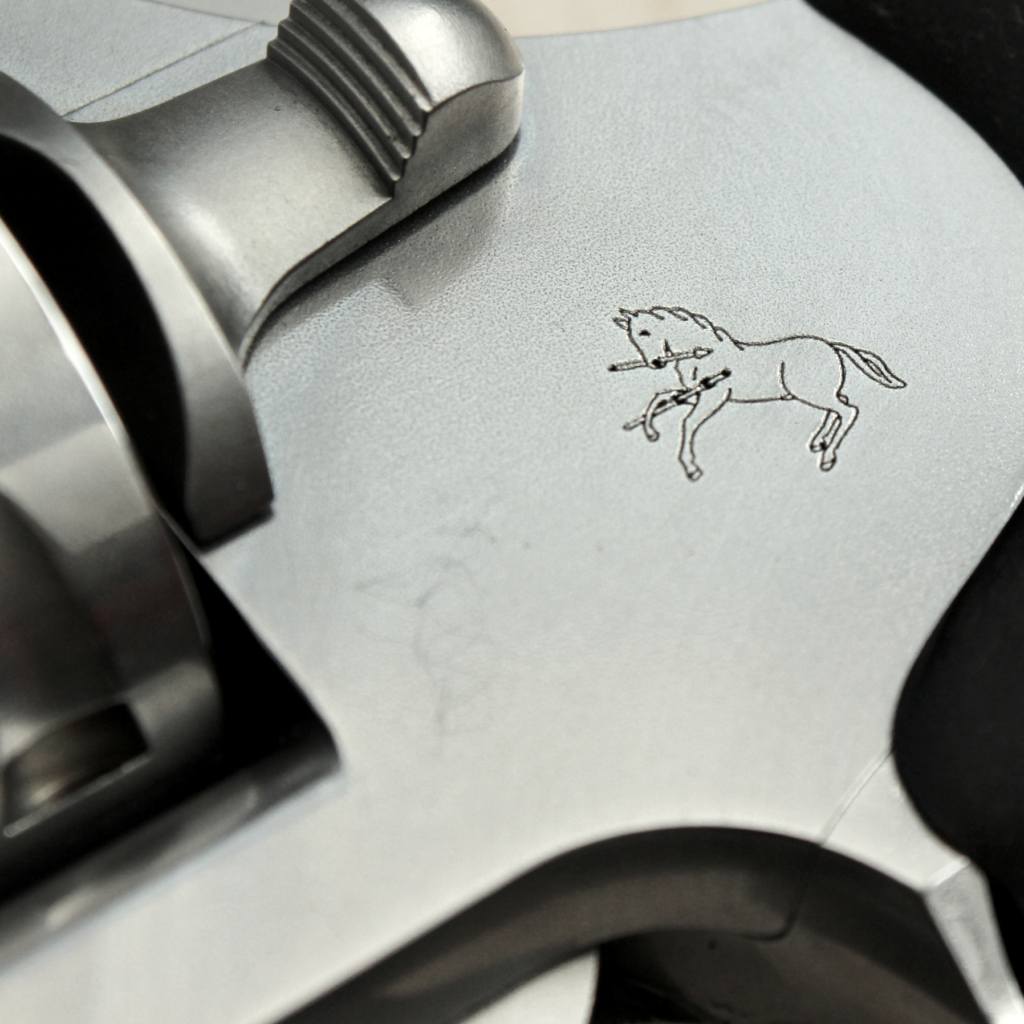
I tested the Colt King Cobra in accordance with our Revolver Testing S.O.P., with one exception that will be explained below, and corrected as soon as possible. Before diving into the results of of the RT-SOP, I will cover the features of this revolver. After concluding the Field Test results I will offer my personal conclusions.
The New Colt King Cobra
The Colt King Cobra is a stainless steel, double action revolver built on a modified version of Colt’s D-Frame. Though released earlier this year there has been precious little in-depth media coverage on this gun, and we’re proud to take an early – and long – look at it here. Let’s start at the nose and work our way backward.
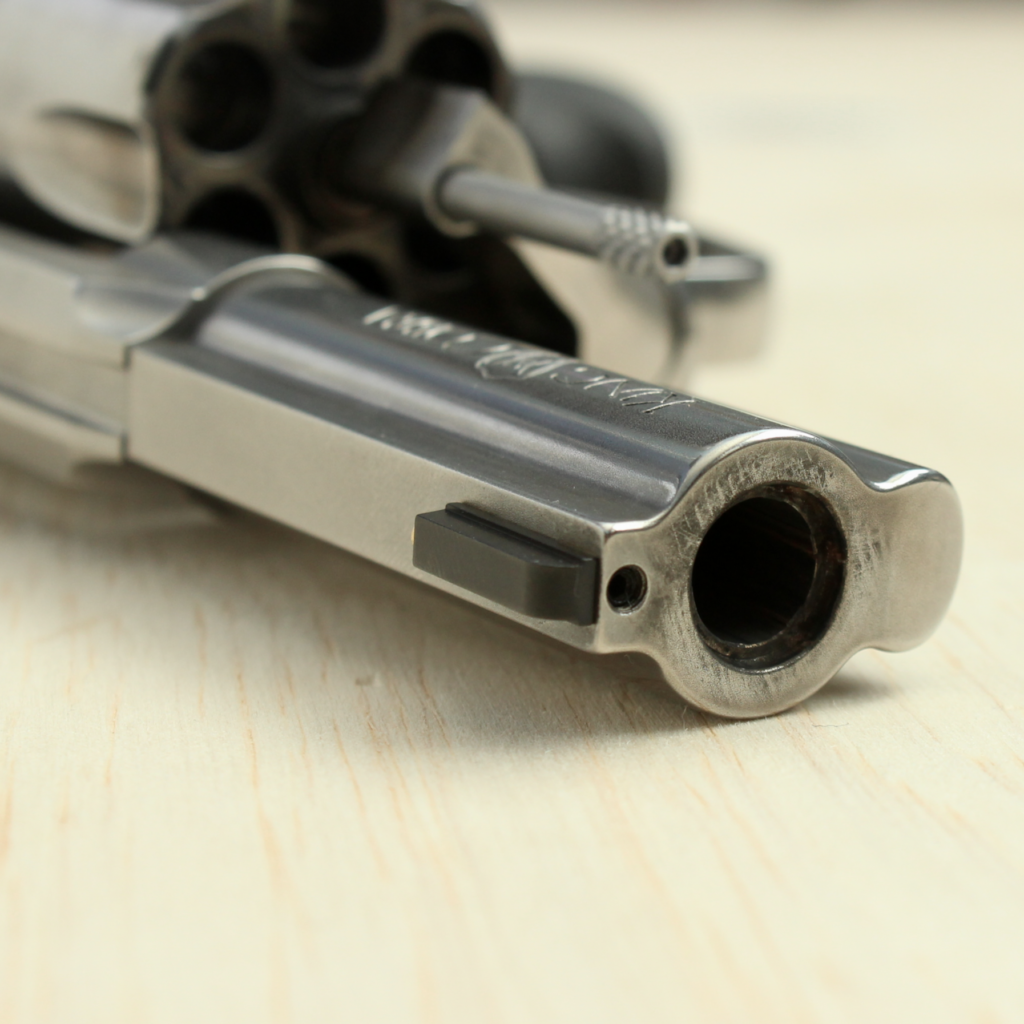
The new Colt King Cobra sports a three-inch barrel that is dressed up with a pleasing full underlug. The muzzle crown is deeply recessed, which both protects the crown and presents a certain aesthetic appeal. Atop the barrel sits a front sight post that I will address separately, further along in this review. Below the barrel is what I consider to be a partial length guide rod with a sharply knurled tip that is shrouded by the underlug. The right side of the barrel is adorned with the words “KING COBRA” in stylized script, along with the classic cobra’s head. These rollmarks are actually applied with the original King Cobra tooling. Below it is a very tidy, “.357 MAGNUM”. The left side of the barrel bears Colt’s serpentine logo along with the city, state, and country of manufacture.
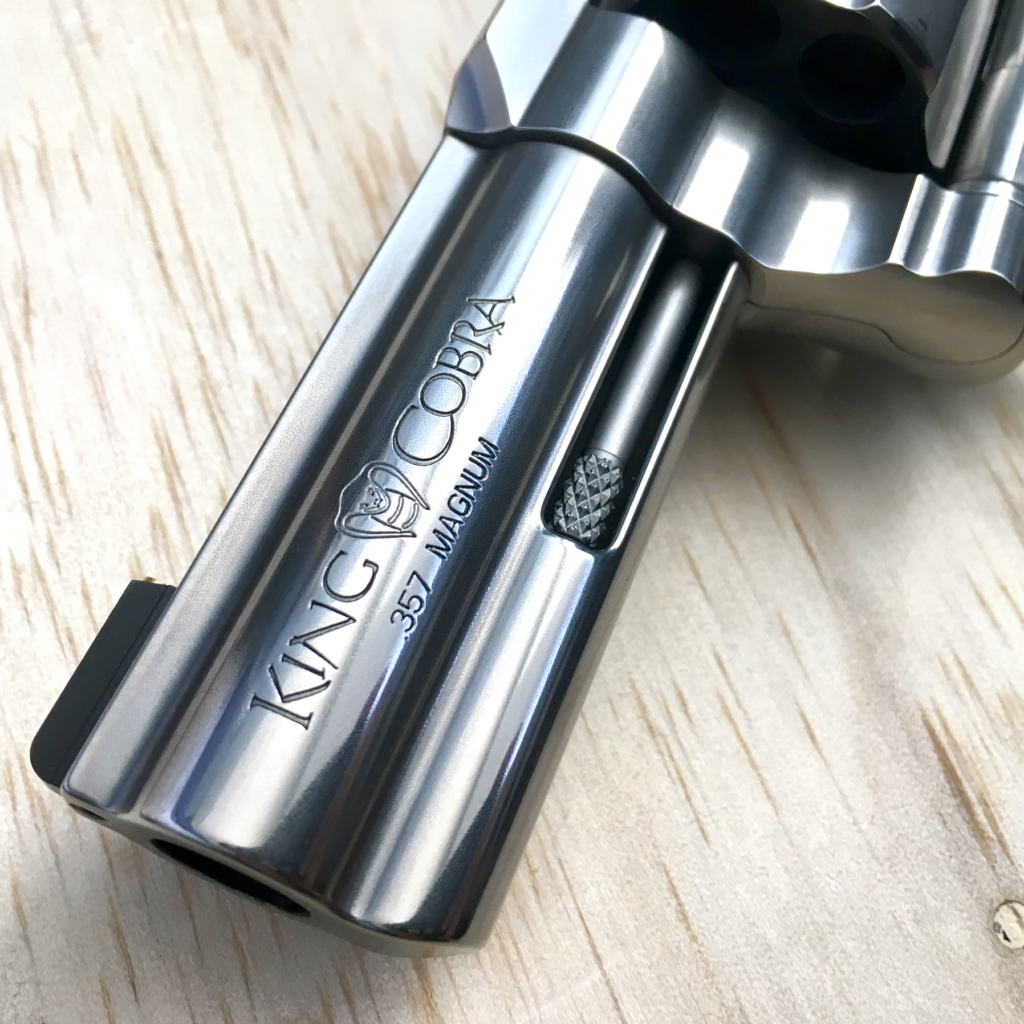
The barrel blends smoothly into the curvature of a conspicuously thick top strap. It is thicker than those of the slightly older Cobra and Night Cobra models to handle the more powerful .357 Magnum cartridge. It is also perhaps thicker than it absolutely needs to be to accommodate the rear sight groove that runs its length.
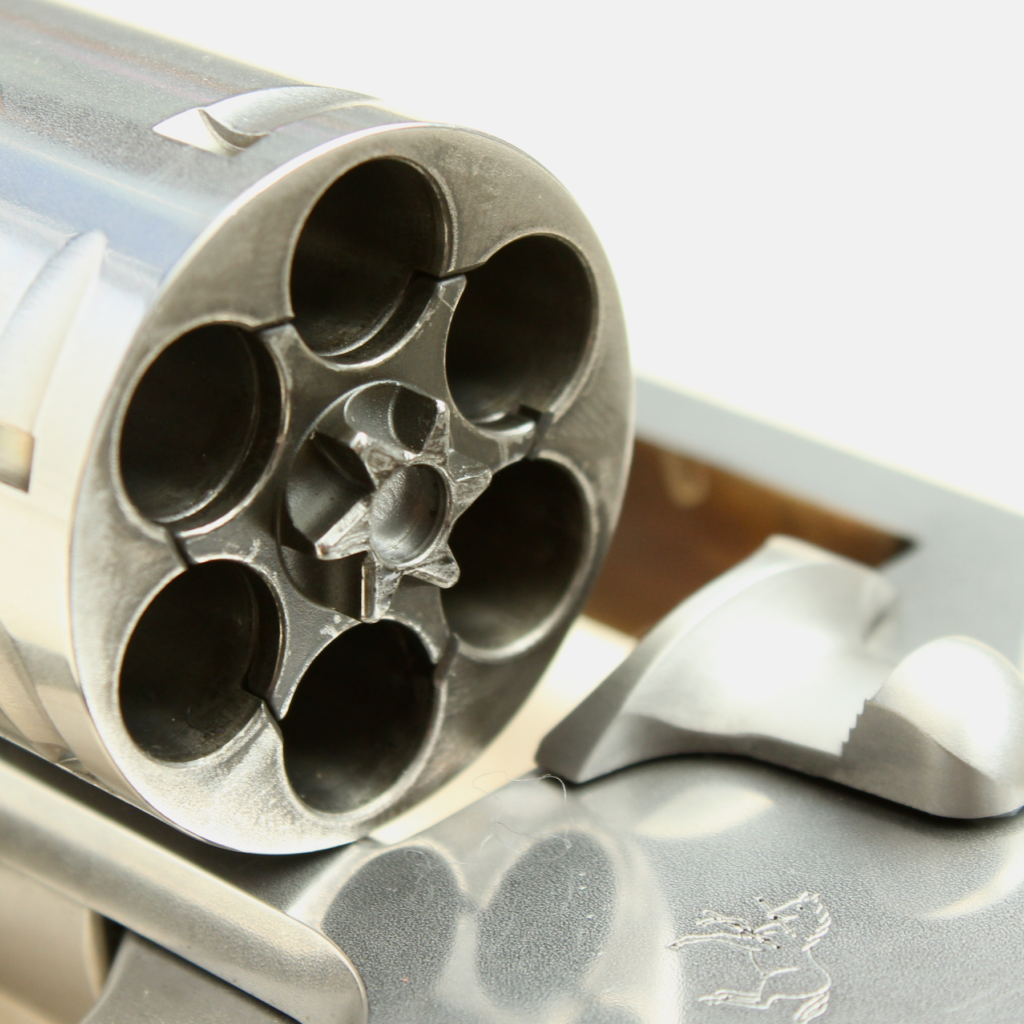
The mid-sized (technically “small” in Colt nomenclature) frame of the Colt King Cobra supports a six-shot .357 cylinder. True to Colt form (and somewhat confusingly to a Ruger/S&W guy) it rotates clockwise. The cylinder is held in place by Colt’s distinctive rearward-activated cylinder release latch. Aft of the cylinder is a spurred hammer with sharp cocking grooves that conceals a transfer bar safety system.
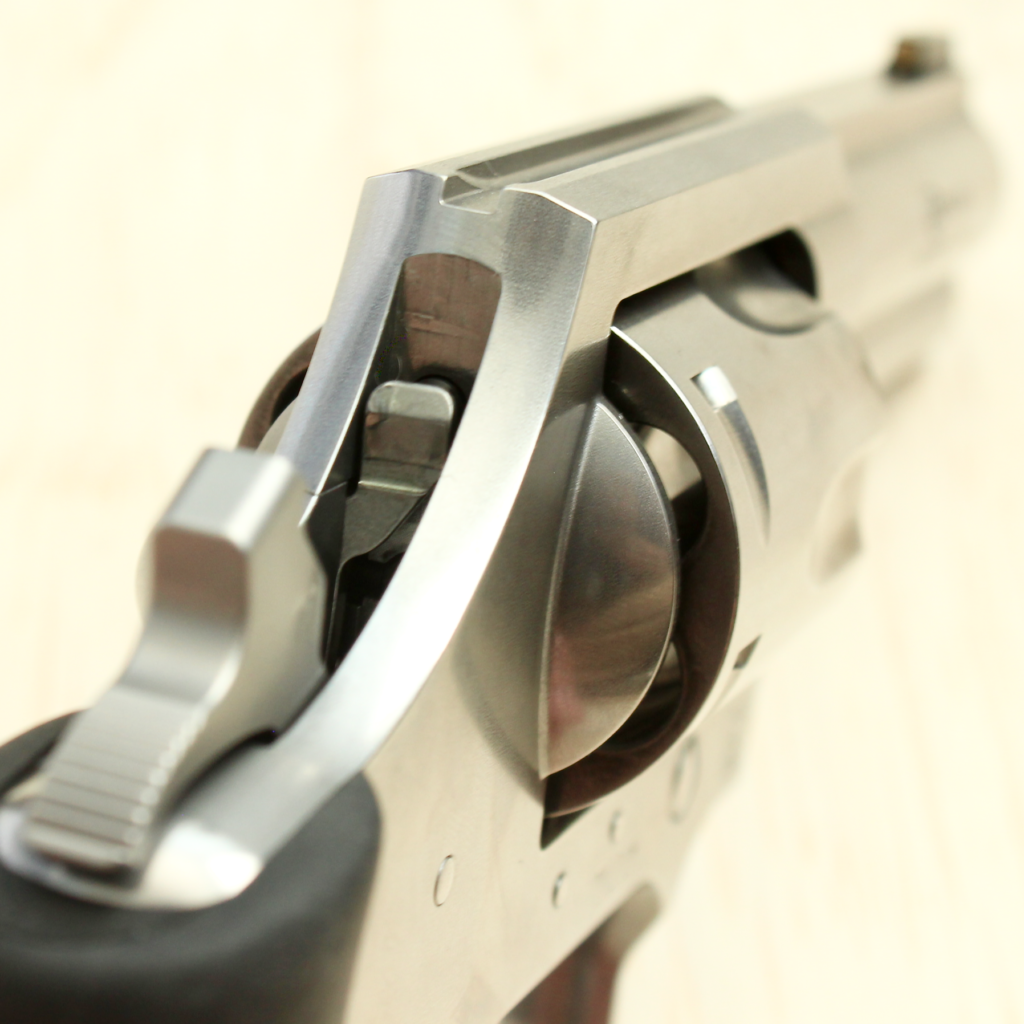
The trigger guard of the new Colt King Cobra, like those of the new Cobra and Night Cobra, looks as though the gun was dropped on it. Rather than a smoothly swept oval, the trigger guard has a noticeable stutter, appearing right below the tip of the trigger. Colt marketing materials indicate this is to increase the size of the trigger guard to facilitate gloved firing.
Having no opportunity to shoot the King Cobra while wearing gloves, I found this made no difference for me. Aesthetically I’d prefer the trigger be smoothly rounded as decades of looking at revolvers have taught us a trigger guard should look. I did find that after a couple of weeks of daily handling I ceased to notice this little distinction.
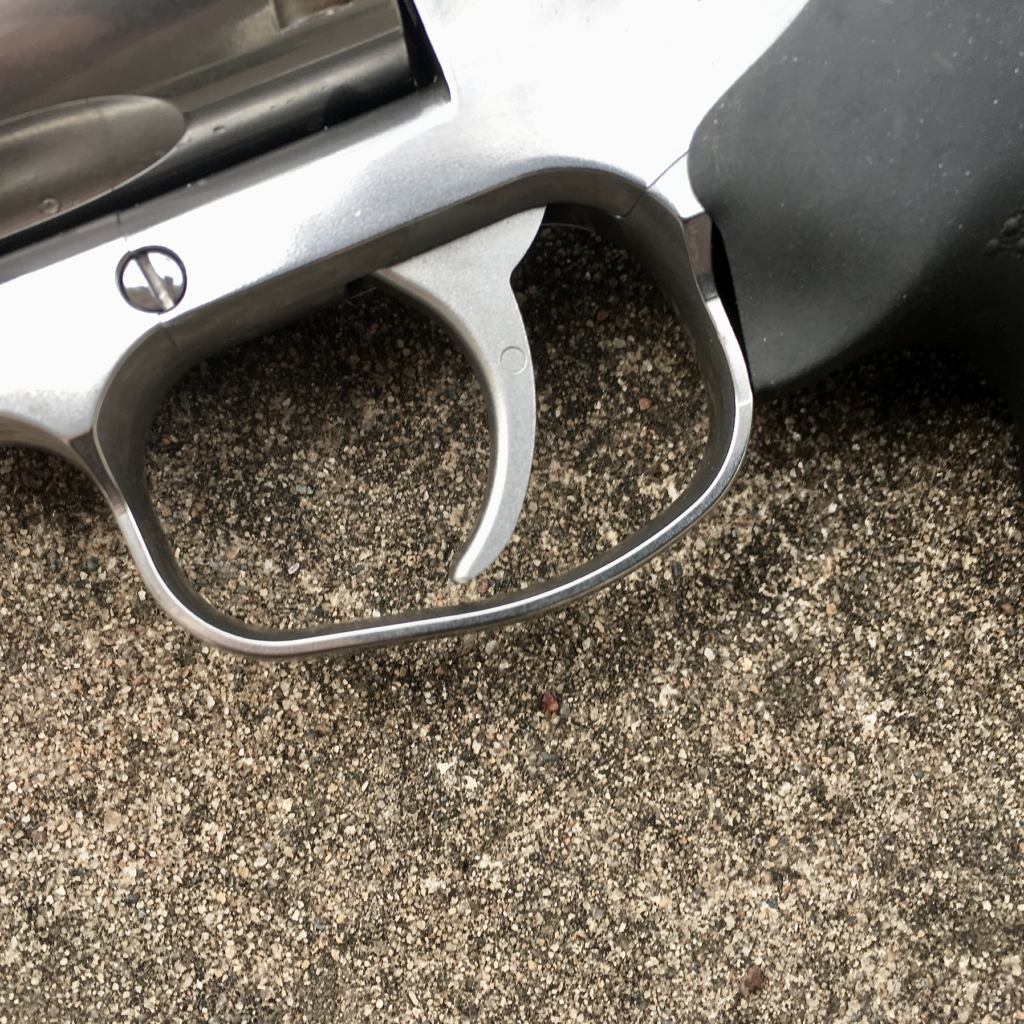
The trigger itself is narrow and smooth. The left side of the trigger bears an unsightly circle from the MIM mold where this component was born. The Colt King Cobra ships with an enlarged, pebbled rubber grip from Hogue. The Hogue handle bears a subtle Colt serpentine logo on each side and encloses the backstrap of the revolver. If you don’t like the factory grips, excellent aftermarket grips for the Colt King Cobra are available through VZ Grips.
A Note on Markings: The right side of the frame bears two markings that do not appear in photos here: the gun’s serial number and a QR code. Both of these have been edited out of the photos that appear here for my own privacy. For exact location of these items, please see the King Cobra owner’s manual, page 36 [opens to .pdf].
Fit and Finish
I’m not one to engage in hyperbole (I generally consider it to be the last resort of the poorly-lettered), so take my word at face value when I say, the fit of this revolver is absolutely superb. I was slightly surprised by this, since I was generally unimpressed with the fit of some early production new Cobras that I saw. The King Cobra represents a massive refinement over the early Cobras, however.
I initially noticed the near-perfect mating of parts in the interaction between the frame and the cylinder crane. The interplay of these two components is one that is easy to overlook, but on the King Cobra it is a thing of beauty. Upon closing the cylinder the leading edge of these two parts mate perfectly, and the photo below doesn’t begin to do it justice. One also notices the fine fit in the action of the trigger, when cocking the King Cobra’s hammer, and when spinning its cylinder. The cylinder feels as if it is spinning on ball bearings. Unfortunately no photograph can illustrate this. You simply have to feel it.
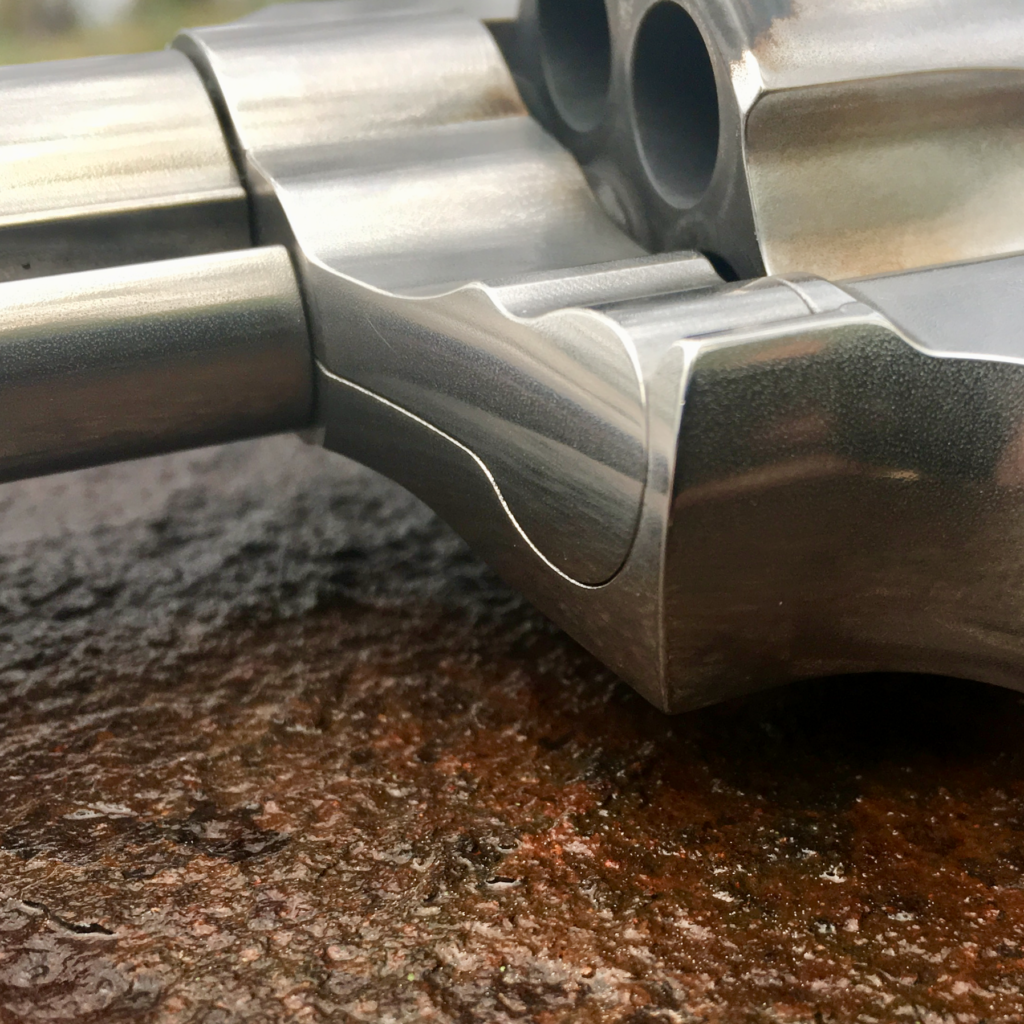
The exception that proves this rule is one little imperfection that sticks out like sore thumb. The sideplate and frame are ever-so-slightly misaligned. The edge of the sideplate is recessed under the frame by a few thousands of an inch. In a lesser revolver this would hardly be noticeable. On the Colt King Cobra, where nary another unintended sharp edge exists, it is almost glaring.
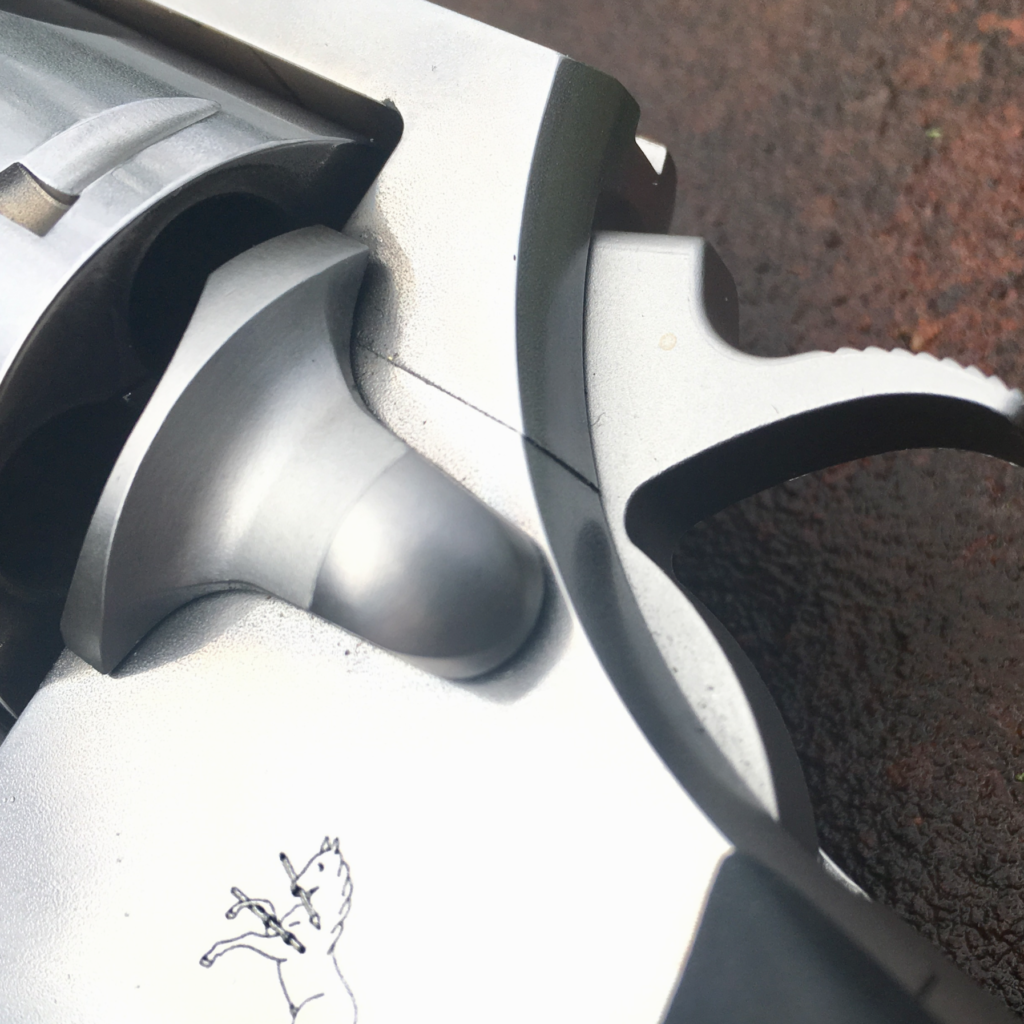
The King Cobra’s finish is a near equal to its fit. All exposed surfaces, minus the cylinder release, hammer, trigger, and front sight, are a mildly polished stainless steel. This is in contrast to more common bead-blasted finishes (as seen on the new Cobra) and is rather handsome, if a bit more difficult to keep free of visible fingerprints.
A Note on the “King Cobra” name: Unaccustomed and emotionally unattached as I am to Colt Revolvers, I brook no complaint with the re-use of the “King Cobra” designation. I understand that some might. To those I would say the following: don’t let sentimentality for a couple of words trick you into overlooking this fine defensive revolver.
Mid-Sized Marvel
The Colt King Cobra fills a notable niche in the defensive revolver market: the medium-sized revolver. Regular readers here may remember back to only a couple of years ago when I lamented the absence of a meaningful, mid-sized, current production, carry revolver. For years individuals wishing to carry a revolver for defense have had to make the same miserable choice. They could accept the discomfort of carrying serious iron and opt for a large-framed revolver like S&W’s L-Frame line or the Ruger GP100. The alternative was to content oneself with carrying a J-Frame/SP101-class revolver with a reduced round count.
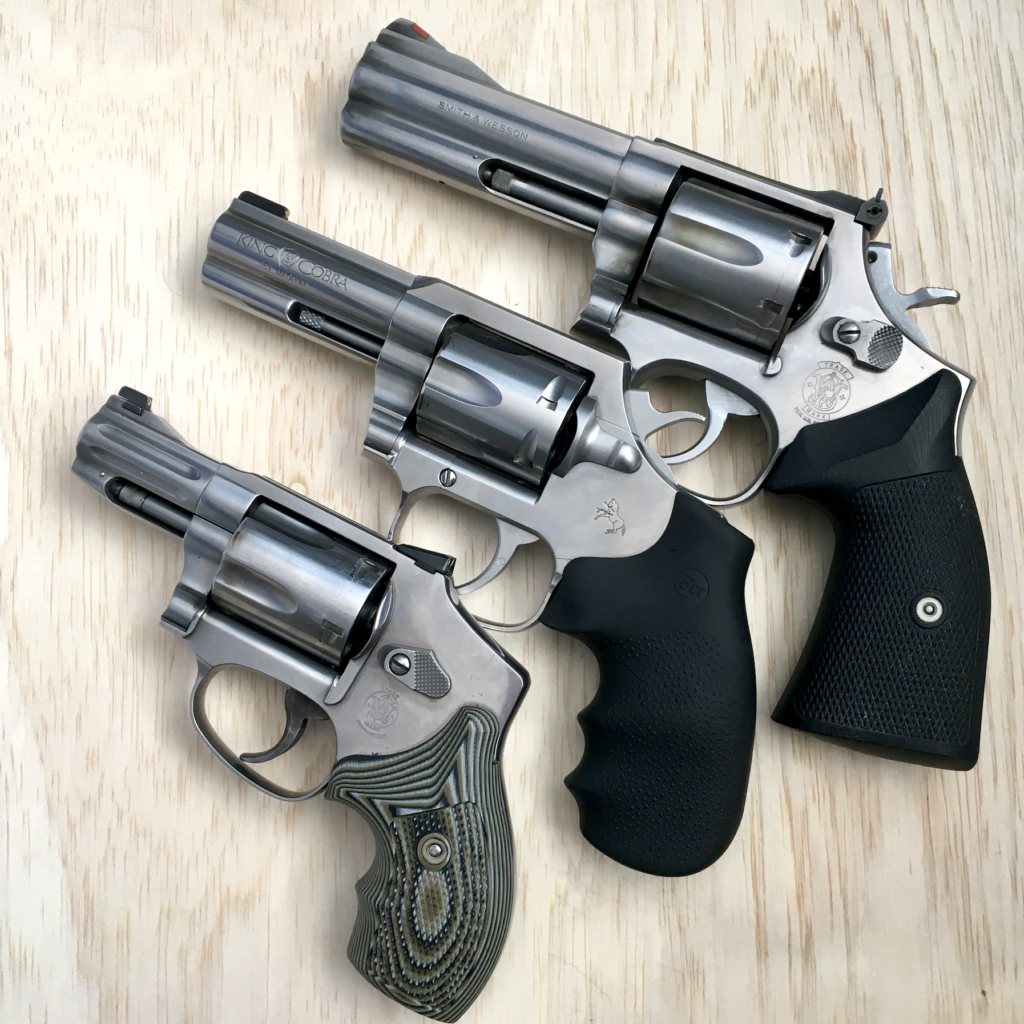
Revolvers between the five-shooter and full-sized revolvers were few and far between. Perhaps the best fit in this gap was (at the time) the S&W K-Frames, but even these are fairly large for concealed carry. The Colt King Cobra slips easily between these two classes of firearms and even though Colt’s considers this a “small” frame I find it to shoot and carry much more like a medium frame gun.
I believe that Kimber also saw this gap in the market when they released the 3″ K6s and perhaps Colt’s sensed the same void. The Colt King Cobra is small and light enough for comfortable, all-day carry. My specimen weighed in at 1 lbs, 12.2 ounces (just 0.2 ounces over an advertised 28). It’s also large enough for real shooting. The large, comfortable grips and trigger (which I will expound upon shortly) are contributors, as are the gun’s size and heft.
This review found me sorely wishing I’d purchased the Yonkers-born wheelgun for direct comparison purposes, but suffice to say, both of these revolvers will probably appeal to the same potential buyers. I believe, due to the slightly larger frame, the Colt’s revolver would edge out the Kimber in a head-to-head comparison for best middleweight round gun.
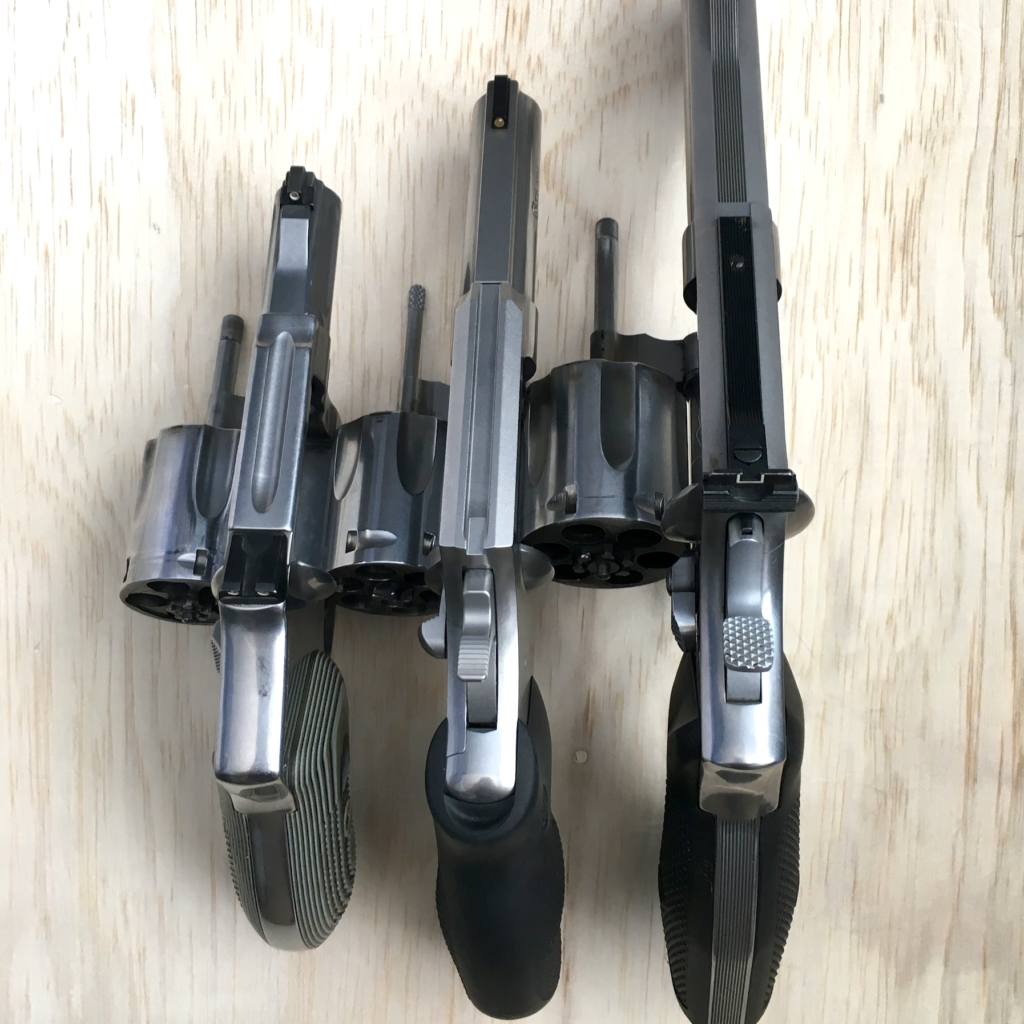
Function: Sights
The Colt King Cobra’s front sight is one borne of thoughtfulness. It is a steel front blade with an inset brass bead. By loosening a single screw just above the muzzle, the end-user can replace it with a tritium or fiber-optic front sight. This is a feature that is sorely lacking in many modern defensive revolvers, and a vast improvement generally over integral front sights.
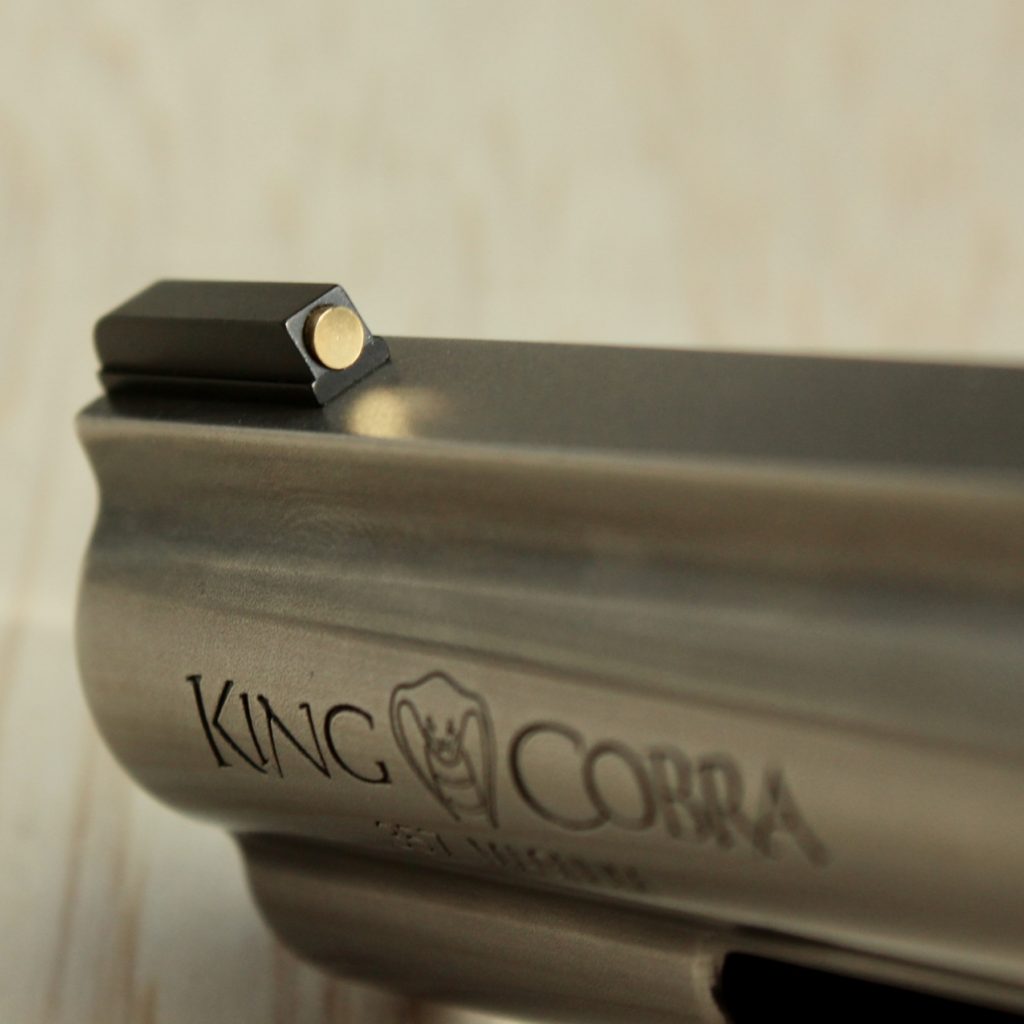
The rear sight on the Colt King Cobra is more traditional, consisting of a milled groove in the top strap. This sighting arrangement is doubtlessly familiar to revolver shooters. In light of the accuracy results below, I don’t dislike this setup as much as I otherwise might. Still, I found myself longing for a version of the King Cobra with an adjustable (at at least better) rear sight, like the original King Cobra. I believe the current rear sight artificially limited the accuracy potential of this standout revolver.

The sight picture is fine for close-in work (of, say 15 yards and under) but difficult to refine at distance. The rear notch is not sufficiently deep to allow one to see the entire front bead. Combined with the sloped outer edges of the rear sight notch, the overall sight picture ends up coming out with a somewhat rounded apex (I tried, numerous times, to photograph the sight picture one sees when the gun is at full extension. I failed.). This hampered efforts at precision at distances exceeding fifteen yards. I understand that the Colt King Cobra is probably not intended to be a forty-yard gun, but a better rear sight could take what is already a good trail companion and turn it into a great one.
Function: Trigger
Having never fired a Colt’s revolver, I was naturally curious about the storied Colt’s trigger. Everyone and their brother seems to have an anecdote about the beautiful, glass-like trigger of the legendary Python. I was excited to try one of these triggers, but also had to wonder if some of the hype was the result of inflated memories of, or nostalgia for, yesteryear.
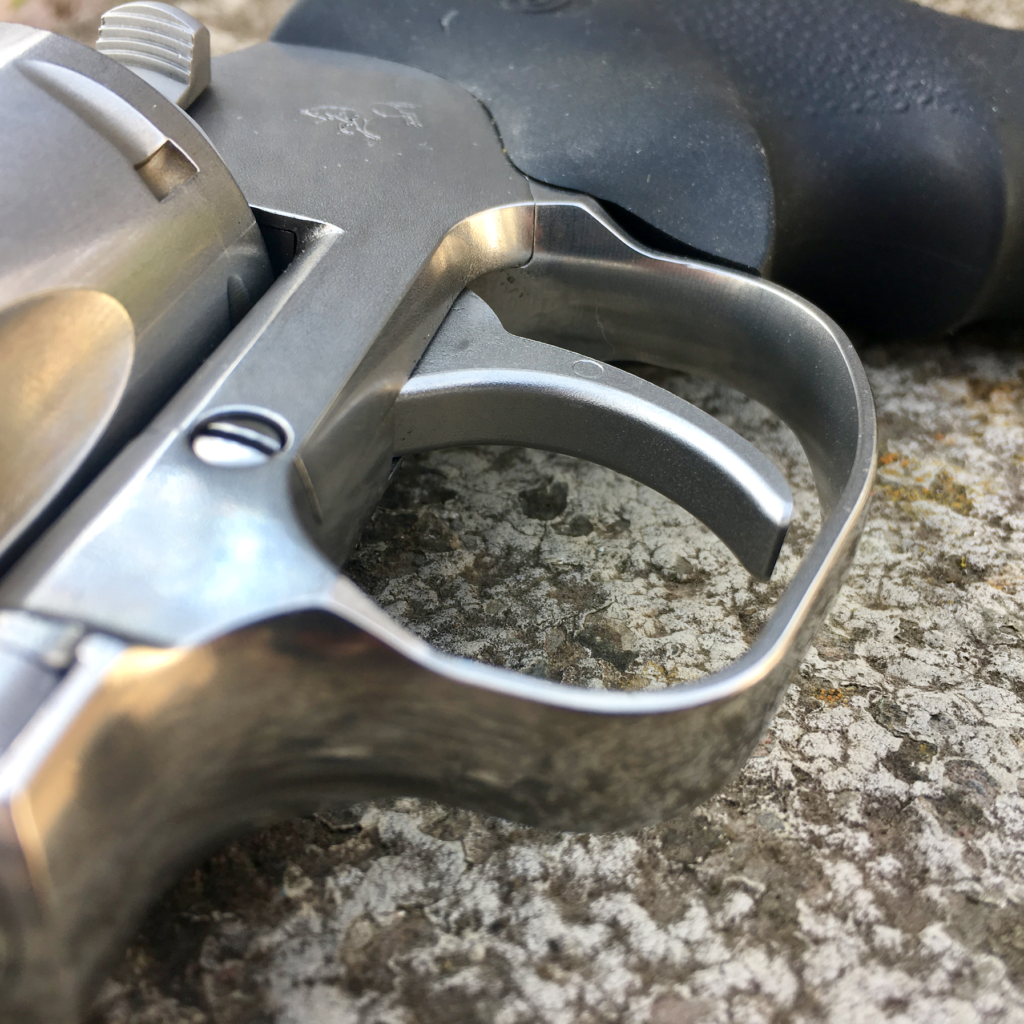
And I have to say, I was impressed. The Colt King Cobra’s trigger was incredibly smooth. It’s difficult to quantify that but it was on par with the smoothest revolvers I’ve ever shot, and is the first time the word “buttery” has made any sense to me in regards to a trigger. The Colt’s trigger famously exhibits “stacking” and becomes gradually heavier as it moves through it’s rearward cycle, but I didn’t find this to be detrimental in any way.
The double action pull weight as measured on my Timney Trigger gauge averages a very reasonable 9 1/4 pounds. This relatively light and incredibly smooth trigger no doubt contributed to the accuracy I was able to squeeze out of the Colt King Cobra. The single action trigger consistently and cleanly broke at an even 5 pounds.
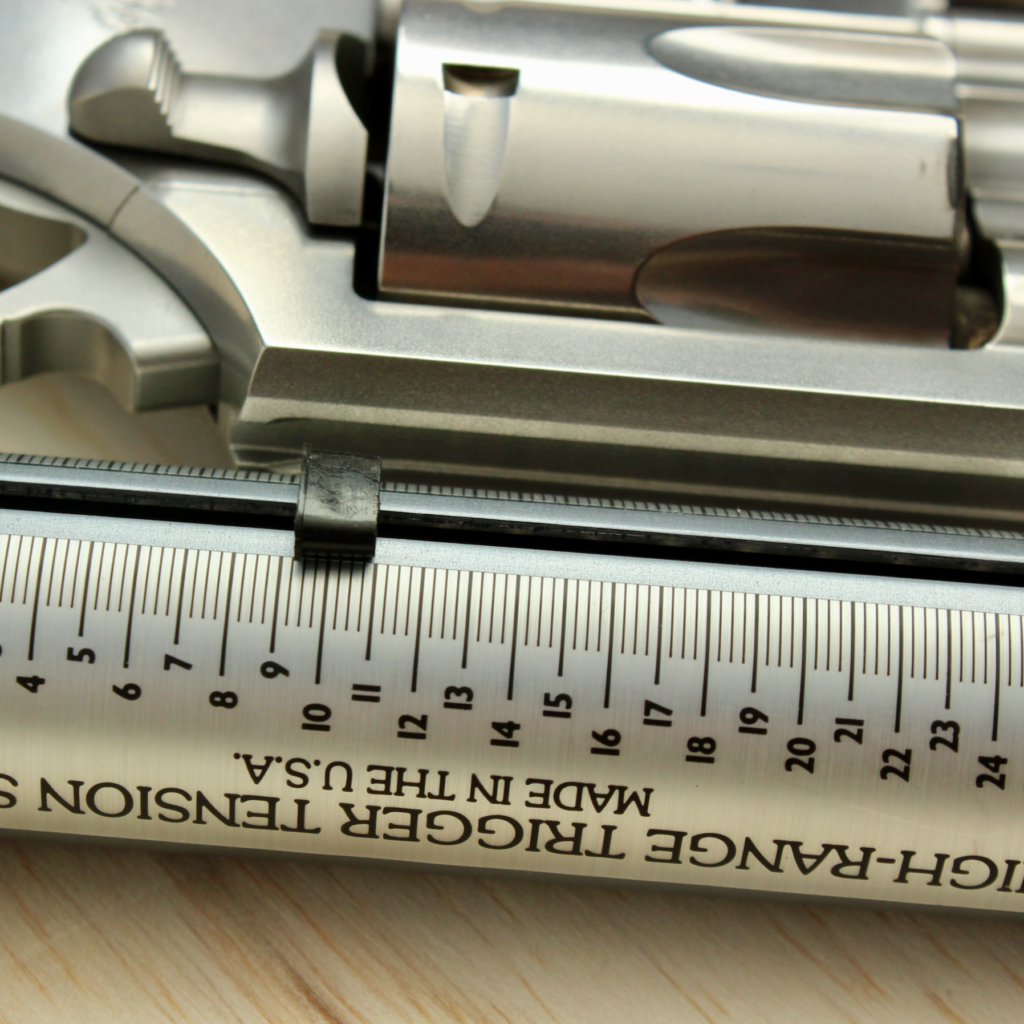
There are a couple minor negatives about the Colt King Cobra’s trigger. The first—it seems to induce what I termed a “premature reset response.” When one completes a cycle of the trigger and releases it, there is an audible and tactile “click” and accompanying drop-off in return-spring tension about 2/3rds of the way through the trigger return. I was wont to arrest the trigger’s forward travel at this point and begin pulling it through its next cycle, only to find the trigger locked up. This didn’t happen often mind you, but enough times that were I adopting the Colt King Cobra as a carry gun I would work hard to overcome this.
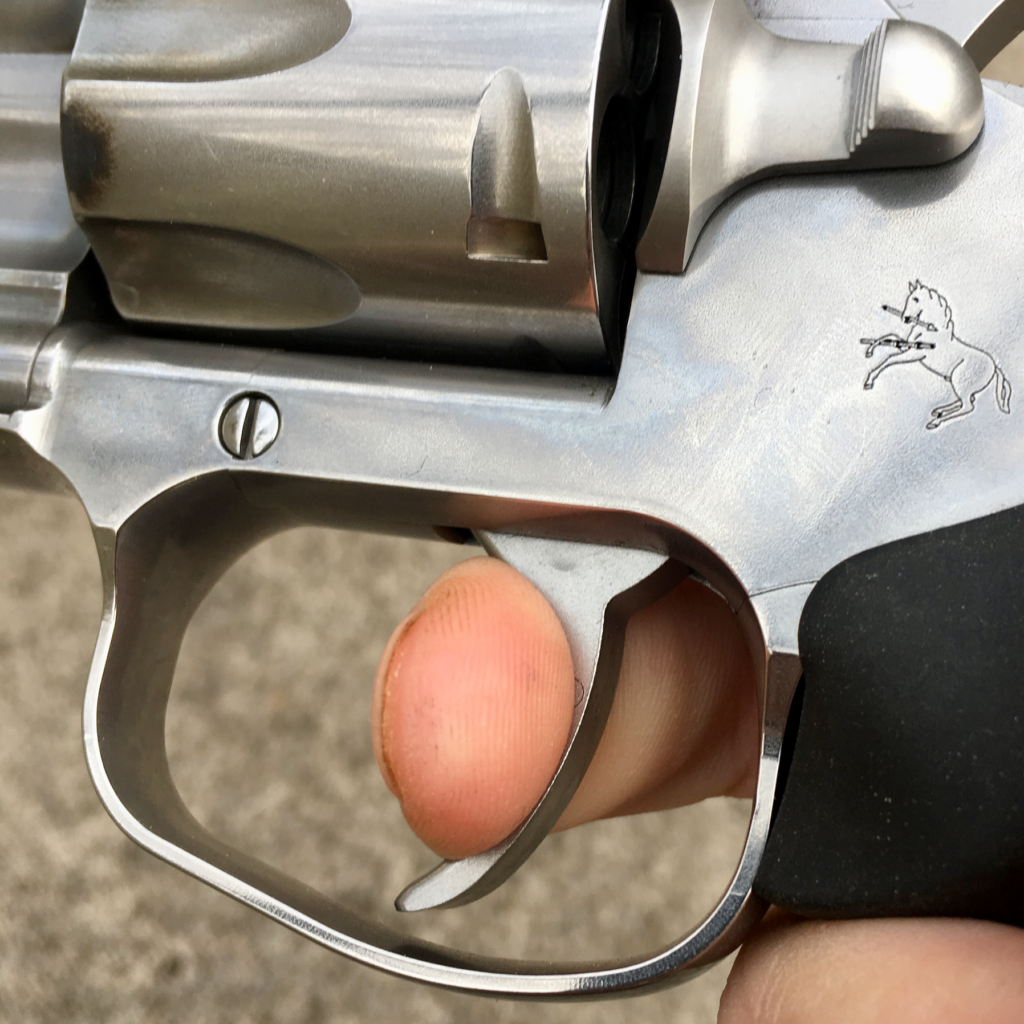
I contacted Mike and asked if this trait was peculiar to Colt. Mike allowed that he had experienced this, but believed it to be caused by a surfeit of work with short-triggered semi-automatics. Initially this explanation sounded good, but then I realized I haven’t had this problem with any of the other revolvers I shoot consistently, which include the GP100, 686, 640, and some others I’m testing. I also observed this issue with my girlfriend. She is far from being a seasoned shooter, but at least 95% of her lifetime shooting has been done with double-action revolvers. The first time she dry fired the Colt King Cobra she locked the trigger up in this fashion.
Mike later confirmed that two older Colt’s revolvers exhibited this same trait. This isn’t “no-go” criteria for me, but I do believe it merits mentioning. If you intend to use the King Cobra for defense of life and limb, mastering its trigger should also mean mastering the trigger’s full reset cycle.
The second minor problem is that the trigger is a bit too narrow. This wouldn’t be an issue in a self-defense situation, but during long range and dry practice sessions it is. It placed a lot of pressure on one particular point in the distal joint of my trigger finger. Initially it was a bit painful; by the end of the session the tip of my trigger finger would be slightly tingly. . . and not in a good way.
Function: Extraction & Ejection
As expected, there were no major issues with extraction and ejection but I do have two minor notes. The first is that the user’s interaction with the ejector rod needs to be vigorous. I found that when “administratively” ejecting brass, one or two chambers wanted to hang on to their brass. This was never an issue if I exerted an appropriate amount of force on the ejector rod. This issue is not peculiar to the Colt King Cobra, as one could expect it with any revolver.
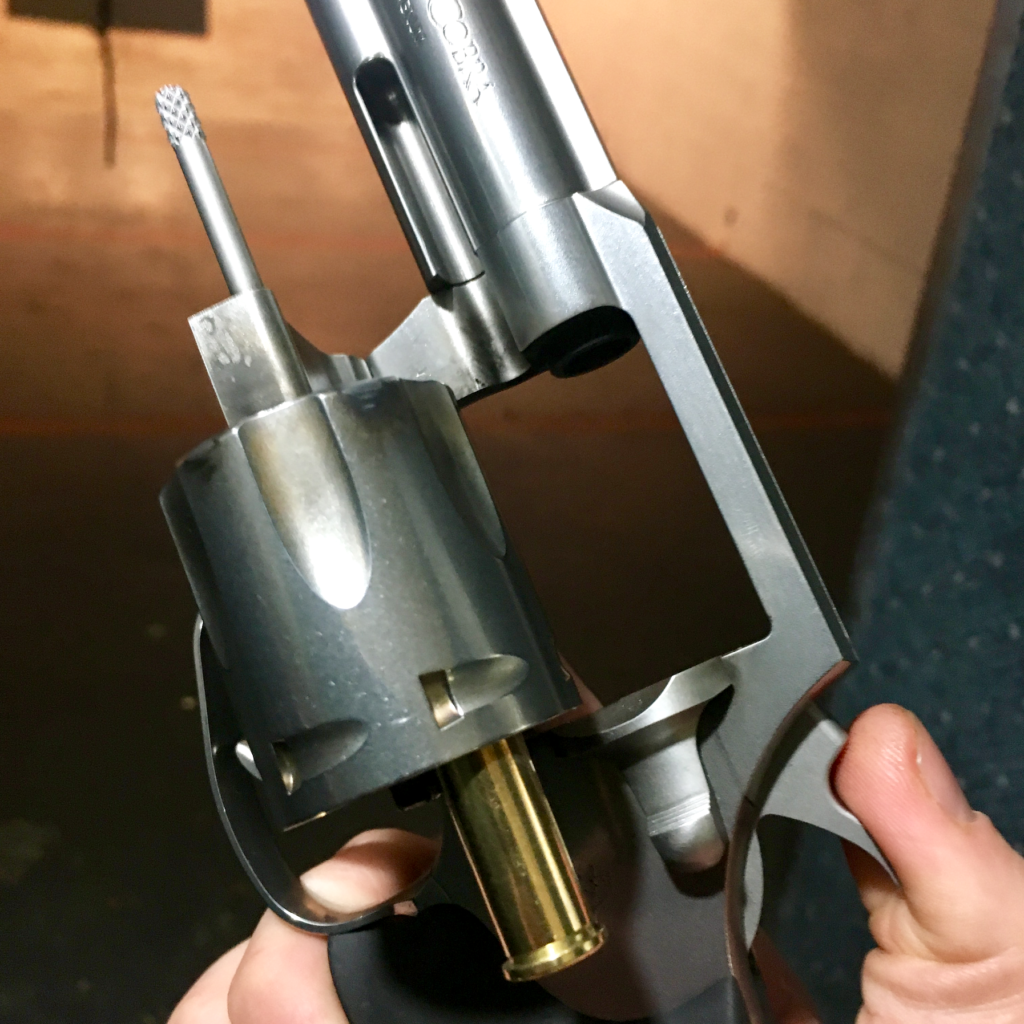
I do bring it up because of the second issue, however. The tip of the ejector rod could be better. The ejector rod’s tip is only scantly larger in diameter than the rod itself (and I believe what our friend Greyson would call a “cigar cutter” format). This creates a natural disincentive to slap the rod with gusto as it tends to cause a lot of pressure to concentrate itself upon a very small surface area on the user’s palm. I’d love to see this revolver refined ever so slightly to include a larger ejector rod tip – again, like the original King Cobra.
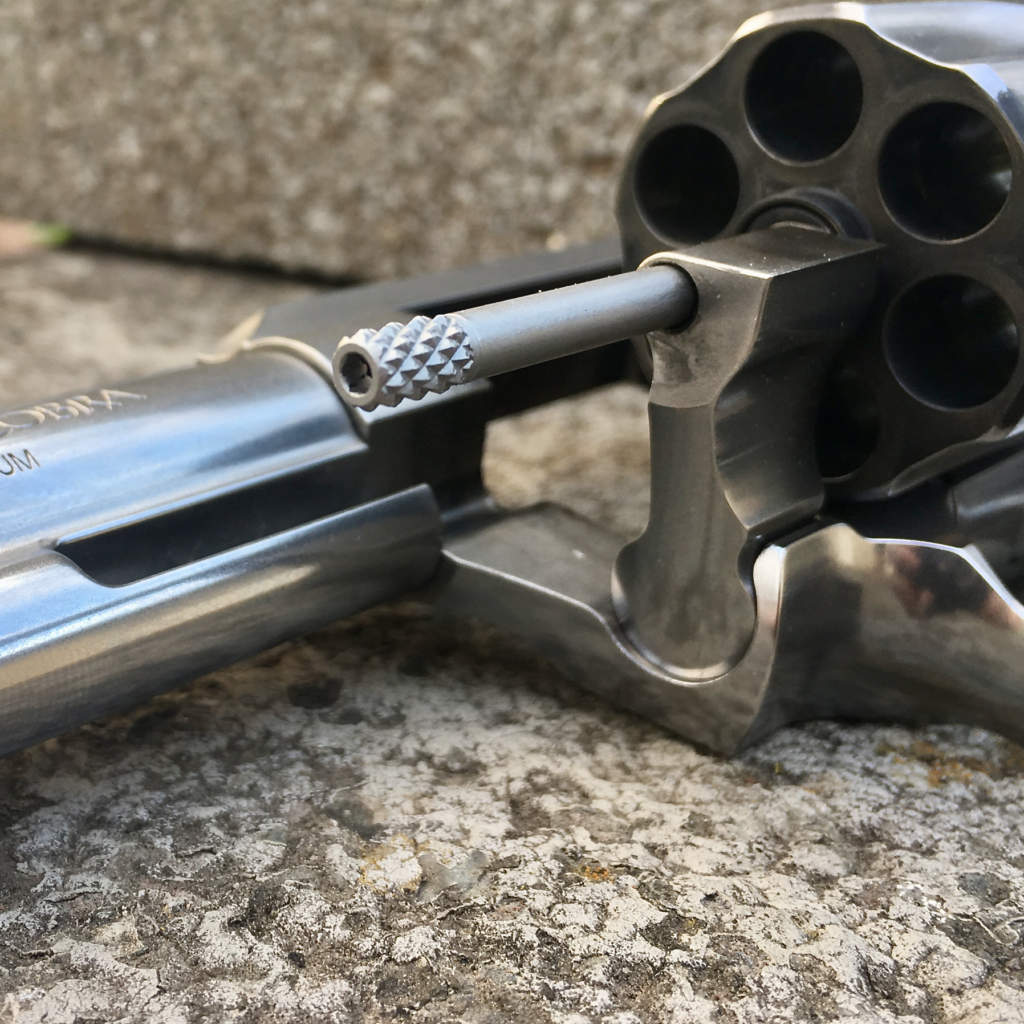
I have run across two reports, one firsthand and one secondhand, of the Colt’s ejector rod tip becoming lodged in the channel when depressed vigorously enough. As a user of the Universal Revolver Reload I was on the lookout for this. I didn’t happen during my first range session so I attempted to induce it. With the power my two hands could muster (and all the punishment the heel of my right hand was willing to endure) I could not replicate this malfunction. That may not fully put the problem to bed, but those are my results.
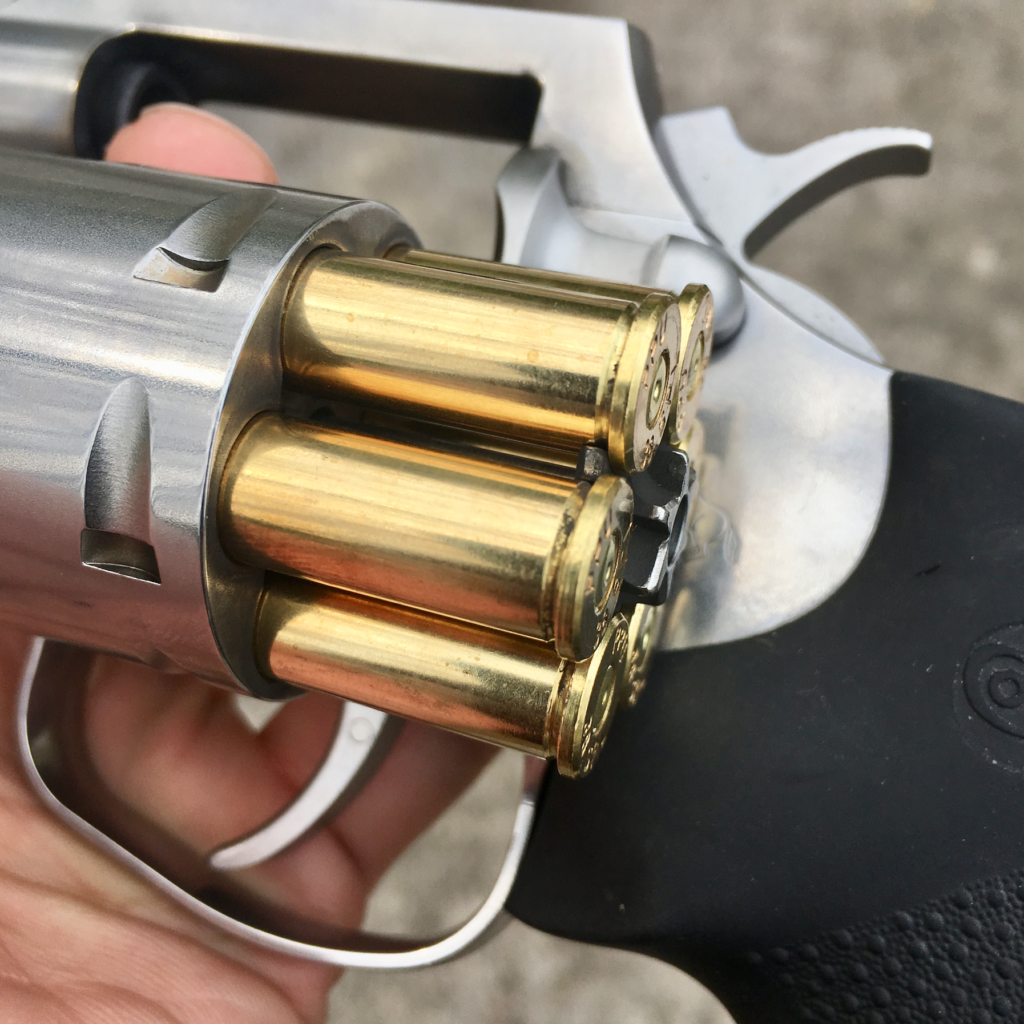
Function & Reliability
I followed our RT-SOP here, firing 500 rounds of ammunition from at least three different manufacturers, over at least three range sessions. My range sessions with the Colt King Cobra broke down thusly:
- 25 March: 150 rounds, no malfunctions of any kind
- 100 rounds Winchester “Service Grade” .38 Special 130-grain FMJ
- 50 rounds Remington HTP .357 Magnum 110-grain SJHP
- 27 March: 150 rounds, no malfunctions of any kind
- 100 rounds Winchester “Service Grade” .38 Special 130-grain FMJ
- 26 rounds Remington HTP .357 Magnum 110-grain SJHP
- 12 rounds Speer Gold Dot .357 Magnum 135-gr. Short Barrel JHP
- 12 rounds Speer Gold Dot .357 Magnum 125-gr. JHP
- 6 rounds SuperVel .38 Special +P 90-grain JHP
- 03 April: 150 rounds, no malfunctions of any kind
- 100 rounds Prvi Partisan.38 Special 130-grain FMJ
- 18 rounds Federal .38 Special +P 130-grain HST Micro JHP
- 6 rounds Speer Gold Dot .357 Magnum 125-gr. JHP
- 6 rounds Hornady Critical Defense .38 Special 110-grain (standard pressure)
- 8 rounds Sig .38 Special +P V-Crown 125-grain JHP
- 6 rounds SuperVel .38 Special +P 90-grain JHP
- 6 rounds Remington HTP .357 Magnum 110-grain SJHP
- 04 April: 50 rounds, no malfunctions of any kind
- 50 rounds Prvi Partisan.38 Special 130-grain FMJ
The Colt King Cobra functioned at 100% with everything I deigned to put through it.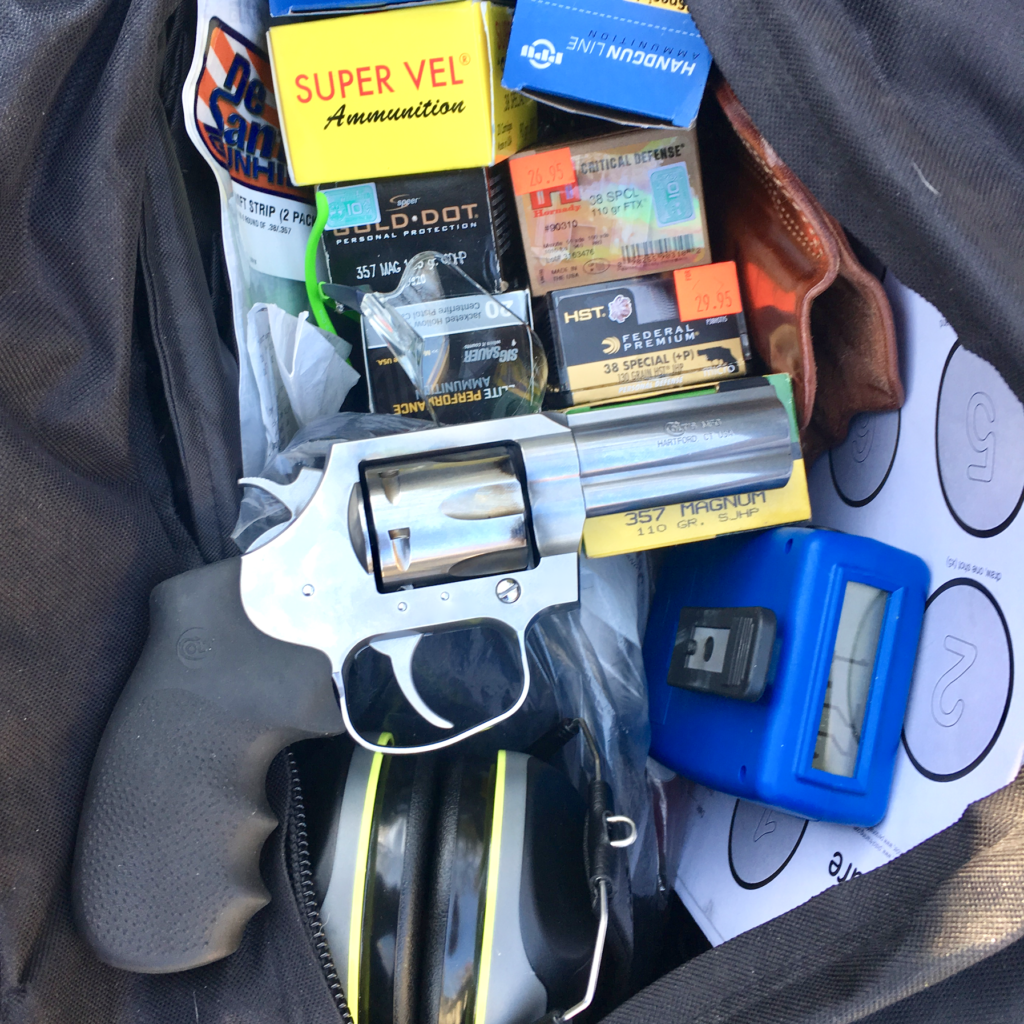
Handling
The confluence of features found in the Colt King Cobra make a gun that is exceedingly pleasant to shoot comfortably and accurately. The weight of this revolver contributes to both factors, absorbing some recoil and helping one steady it at arm’s length.
Though I do have a disinclination toward grips with finger grooves I found the factory Hogue extremely pleasant. Its enlarged circumference placed my trigger finger perfectly on the trigger and permitted an exceptionally strong firing grip. The soft rubber perhaps cushioned recoil somewhat, but more importantly prevented slipping of the hands under the forces of recoil.
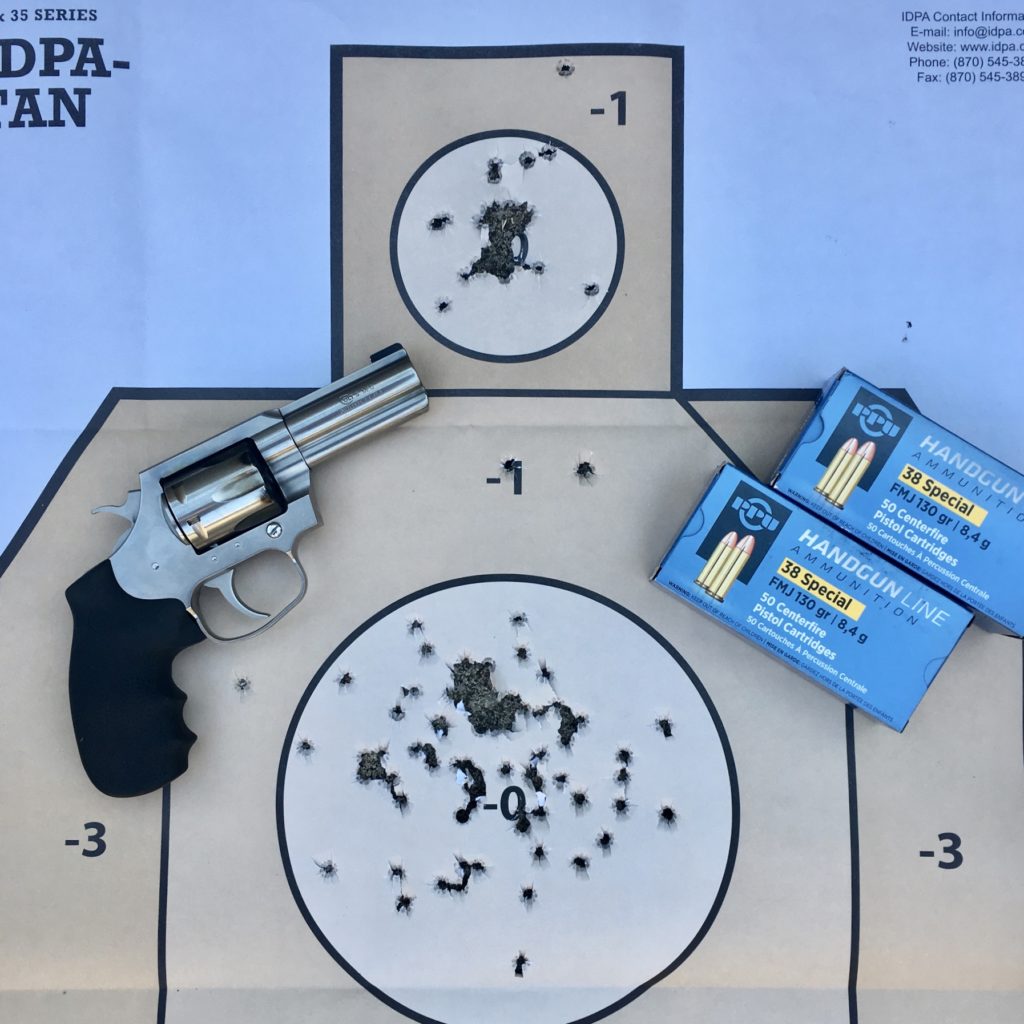
Recoil was extremely manageable with .38 Special and .38 +P ammunition. With a firm grip it was possible to lock the gun in place and run it about as fast as I’d run anything. I’m surprised by this only a little. Though I repeat myself, I attribute this to the gun’s large grip and 28-ounce heft.
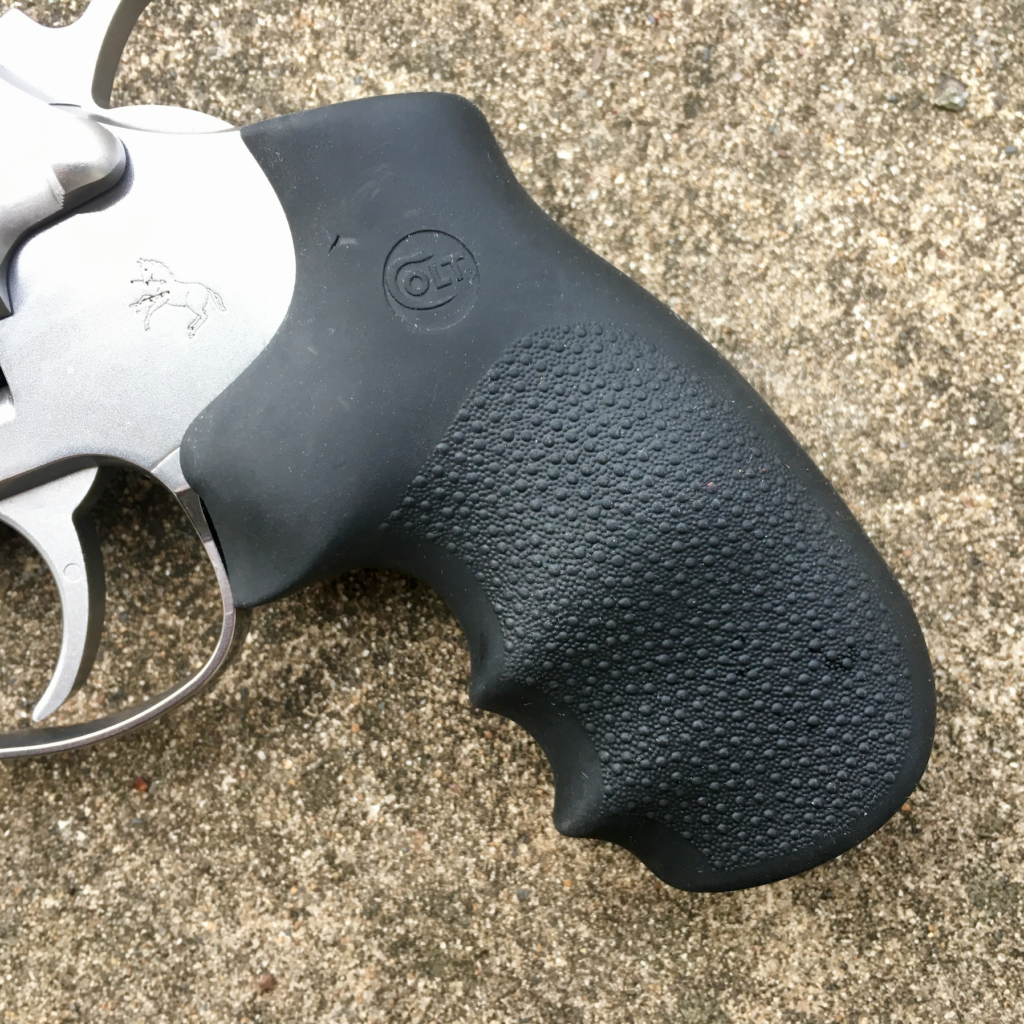
Recoil was a bit more spirited with .357 Magnum ammunition. Some softer-shooting Magnum loads were comfortable, and dare I say, even controllable. Loads of this ilk are the 110-grain Remington SJHP and the Speer 135-grain Gold Dot Short Barrel loading. I didn’t have the stomach for much of the heavier Magnum offerings, and limited my shooting of them to under two dozen rounds. While not painful, recovering from recoil is a fairly lengthy affair.
Accuracy
That beautiful trigger, lengthened sight radius, and the ability to acquire a firm, comfortable grasp permitted accuracy beyond what one typically expects of a small revolver. I fired the prescribed two iterations of Dot Torture. The first was fired at three yards with rounds 50 through 100. I managed to score a 48 out of a possible 50.
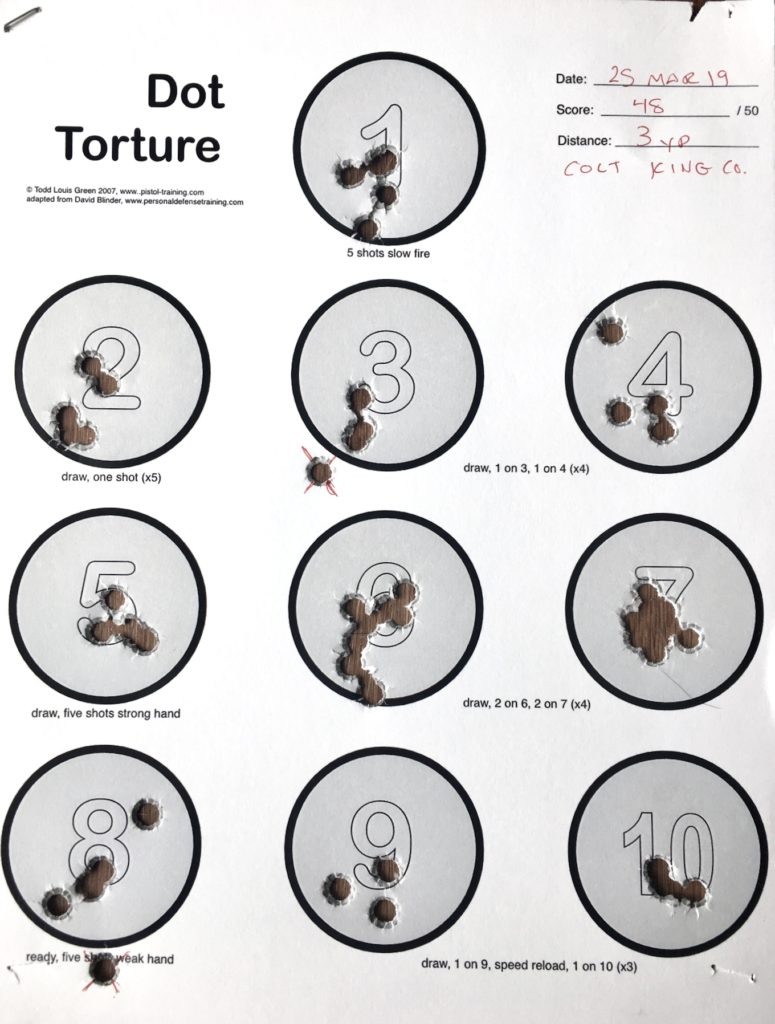
The accuracy testing iteration sparked an internal debate. I debated on what distance from which to test the accuracy of the Colt King Cobra. Our RT-SOP specifies a distance of 10 yards for concealed carry guns and 25 for field/duty-sized revolvers. With it’s medium size and 3″ barrel, shooting at a mere ten yards made me feel like I was doing the gun a disservice. Nonetheless, I fired the first test string at 10 yards using the Speer Short-Barrel Magnum load (135-grain). The photo below illustrates that group.
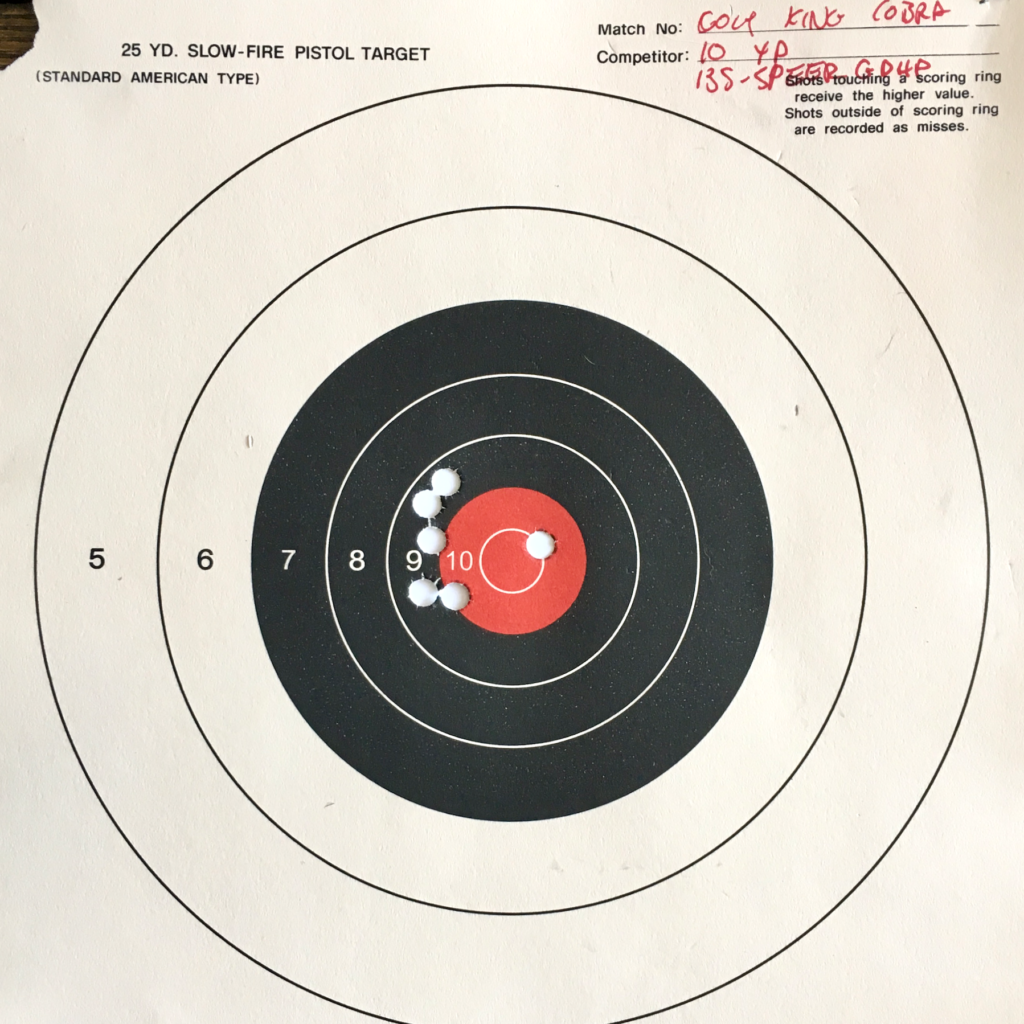
The group was so good, I decided to push the distance out to 15 yards. When I ran the target back in I almost couldn’t believe my eyes. With the exception of one shot (the first one, and completely my fault) the group was almost as good at fifteen as it was at 10.
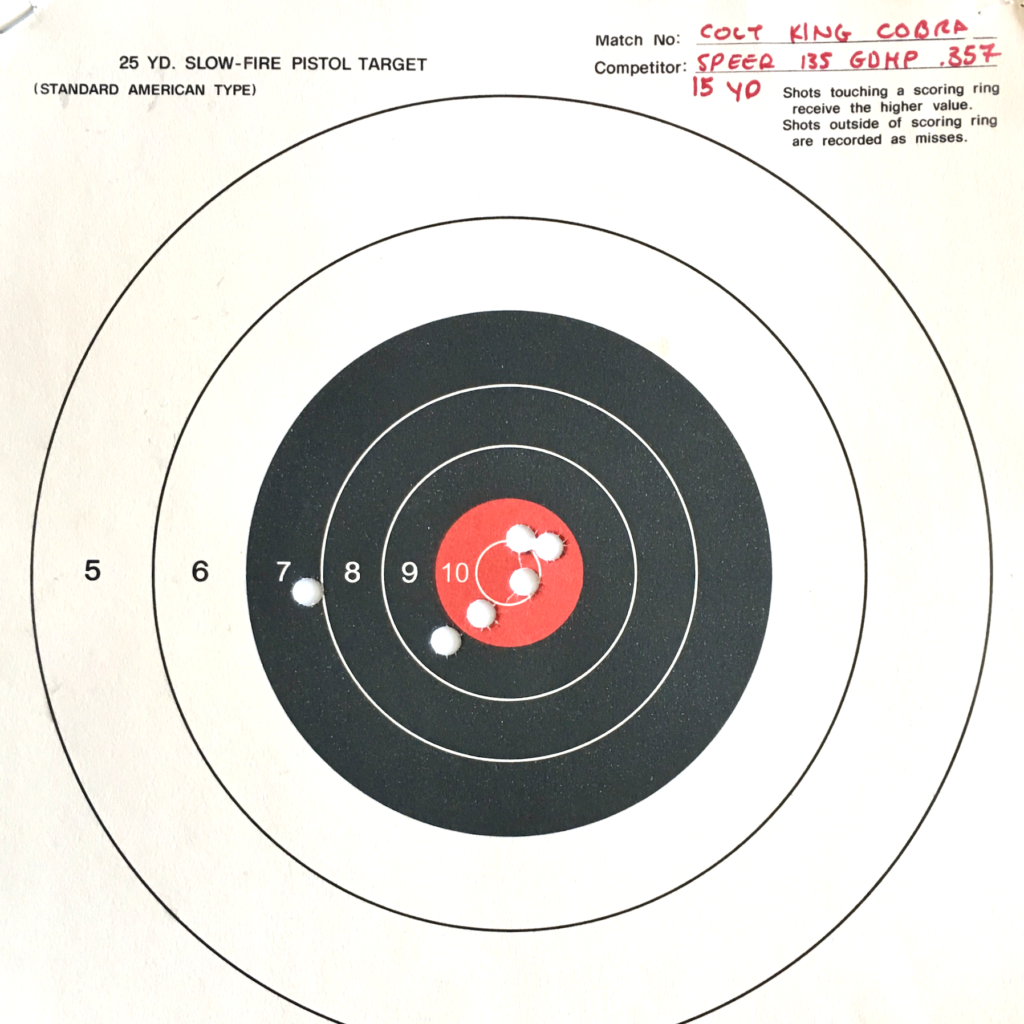
I didn’t know what to make of that. I almost considered shooting all successive groups at fifteen yards. I might have, had the very next load not been the Federal .38 Special +P 130-grain HST Micro. The King Cobra did not like this particular load†. My first two groups at the fifteen-yard line were both at least five inches in diameter, so I moved the target back to ten and stayed there.
In addition to not particularly caring for the premier load from Federal, the Colt King Cobra seemed to demonstrate a preference for the other two .357 Magnum loads I grouped: the Remington 110-grain semi-jacketed hollowpoint and the full power (and I mean FULL power) 125-grain Speer Gold Dot. Excluding fliers that were almost certainly not the fault of the gun, the worst of the .357 Magnum groups were tighter than the best of the .38 Specials††. Below are the six other loads for which I recorded groups.
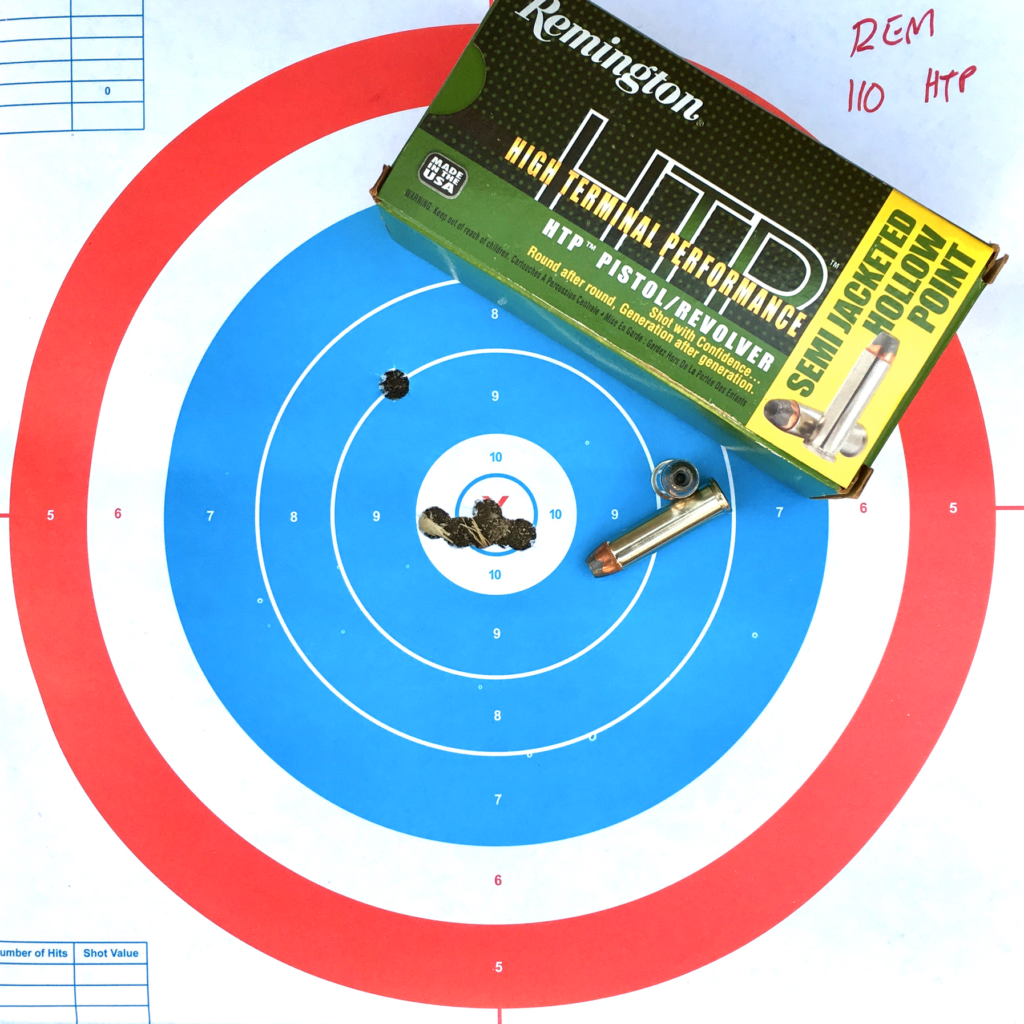
The Remington HTP 110-grain SJHP load (above) was loved by the King Cobra. I shot 82 rounds of this loading and all of them grouped surprisingly well, though this is only one I photographed. This load produces a mighty roar and a massive muzzle flash, but isn’t otherwise intolerable to shoot.
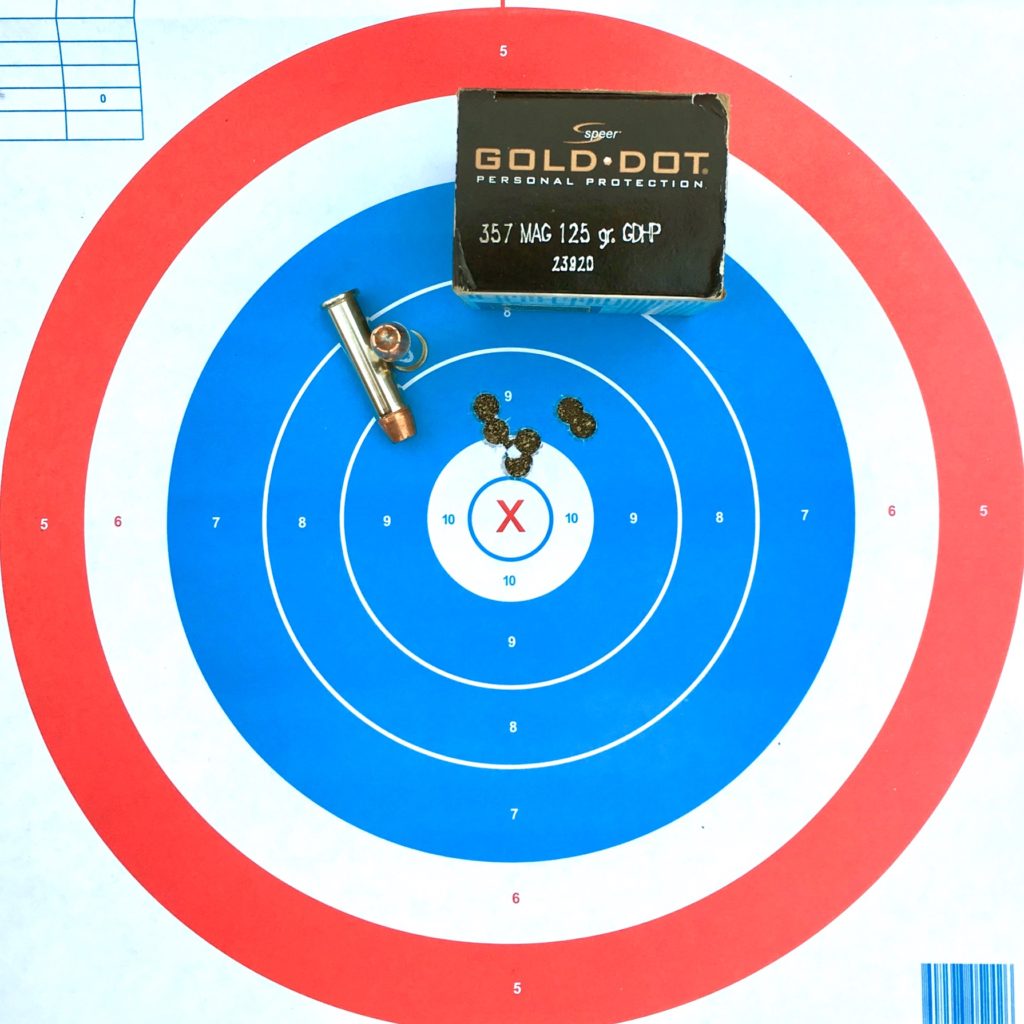
Despite the intense muzzle flash, noise, and recoil generated by Speer’s full-on 125-grain Gold Dot, the King Cobra seemed to like it.
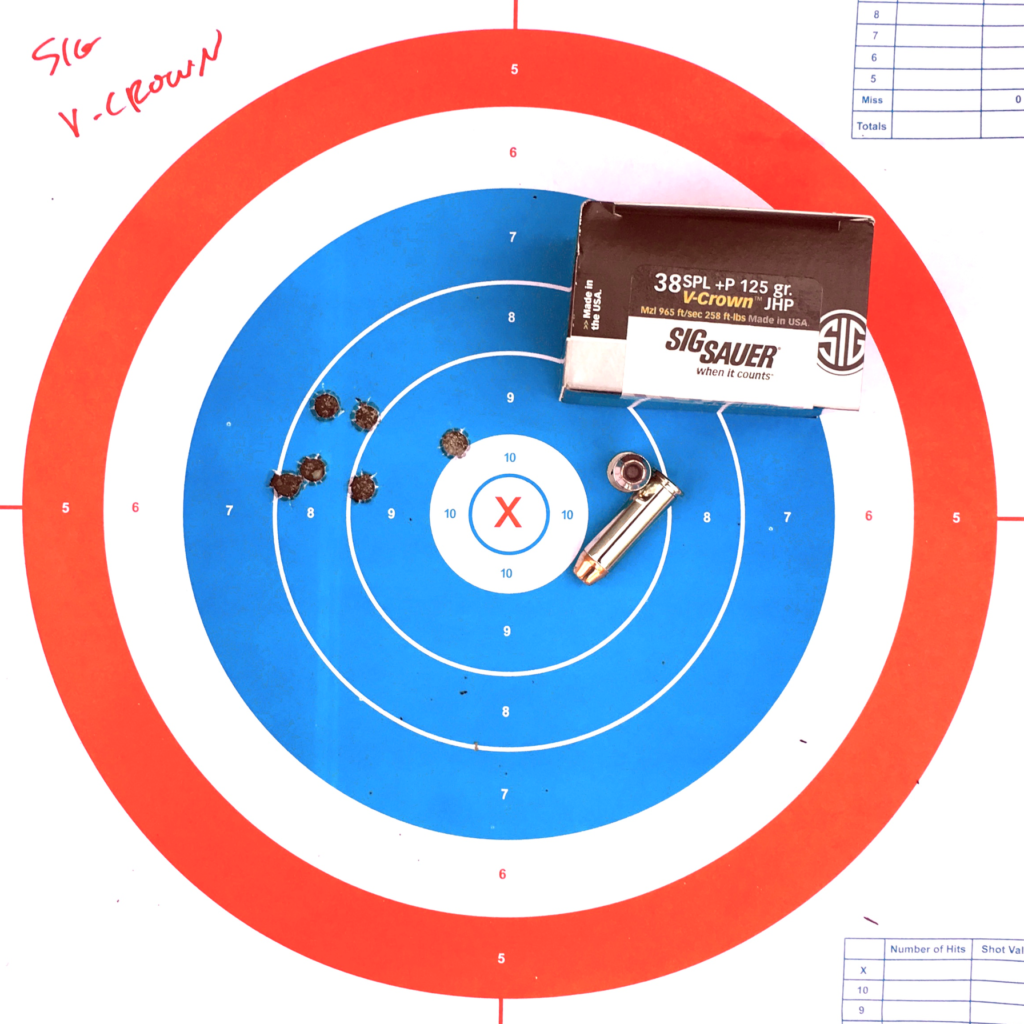
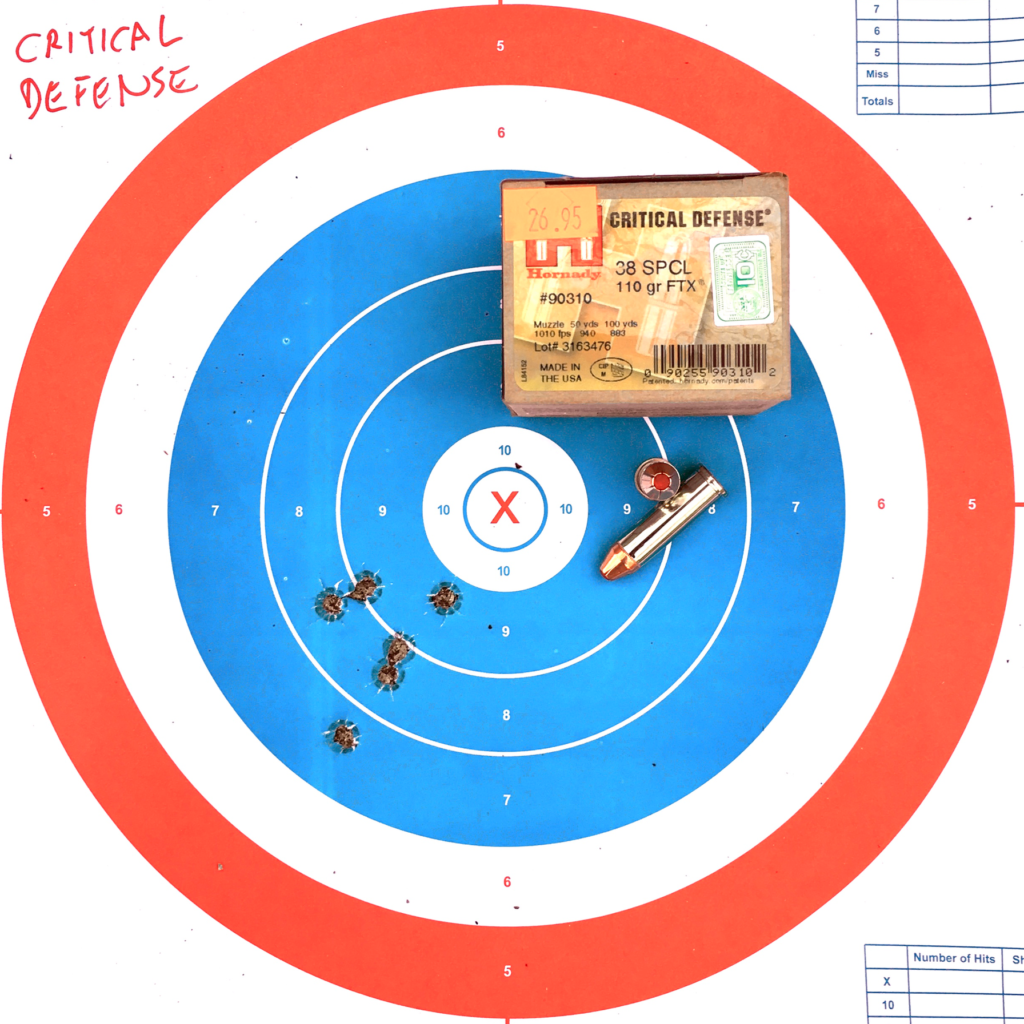
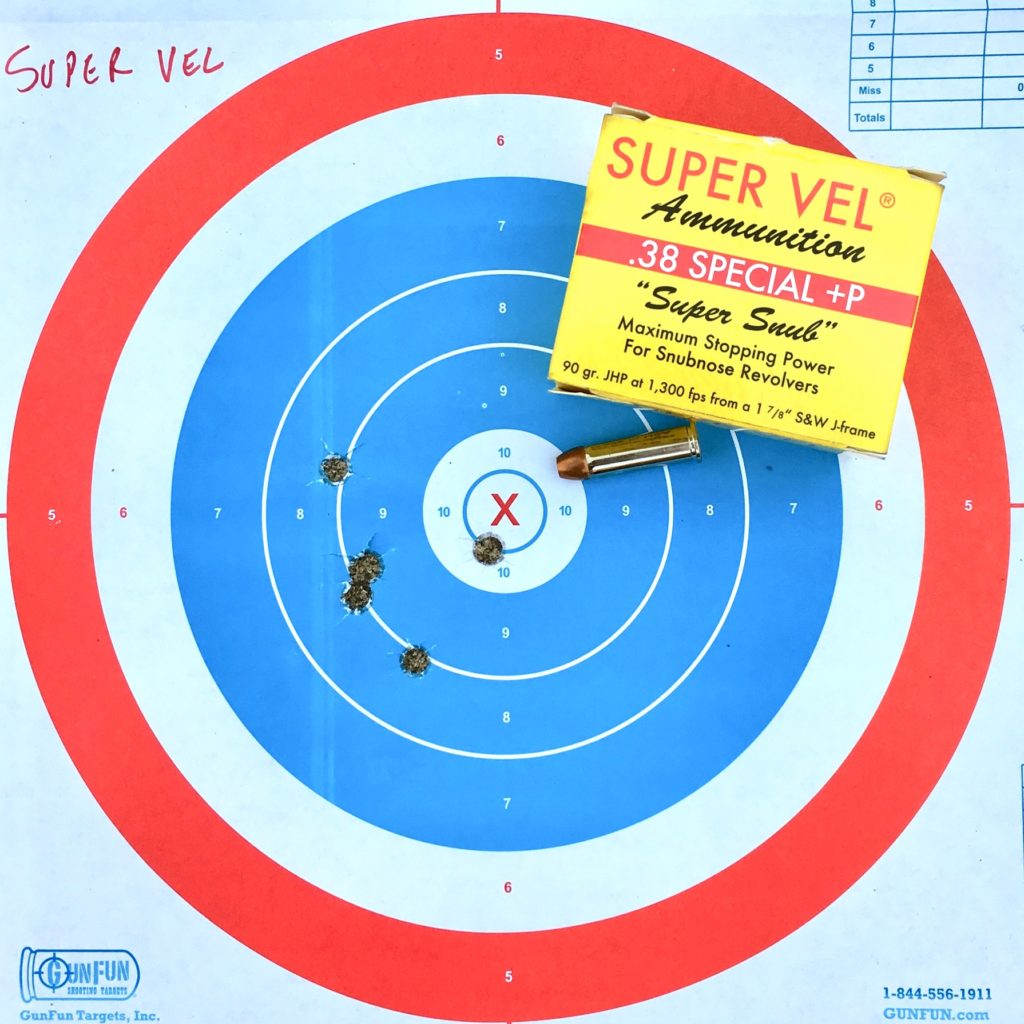
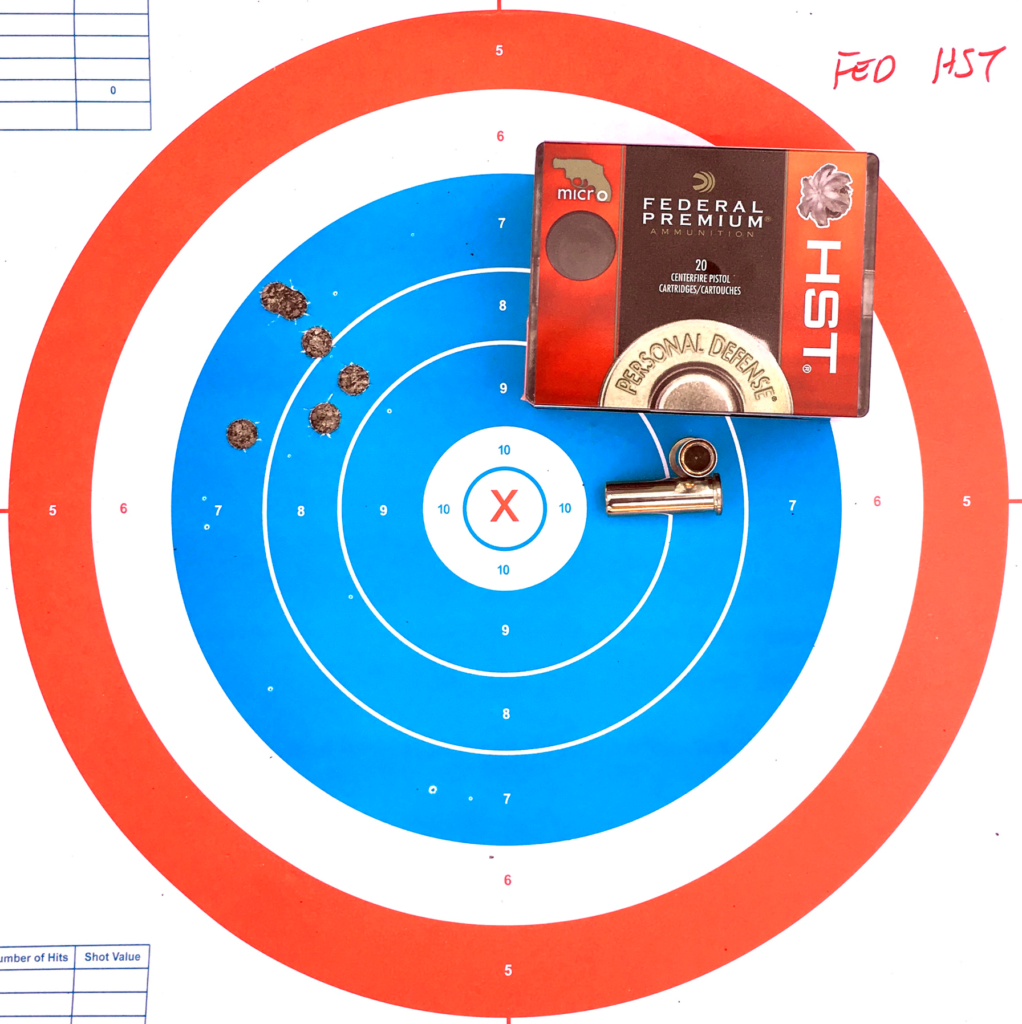
This group is by far a “best of three” with the Federal Micro HST .38 Special, which performed somewhat erratically for me.
Dot Torture session two was also impressive. Instead of firing it at the same three yard where I’d fired the first iteration, I backed up to a full five yards. I pulled of a 47 out of 50. I know I dropped a point from the first Dot Torture session, but I’m OK with that considering the increase in distance. By comparison I only managed to pull off a 44 at three yards the last time I shot my 640, a gun with which I have many times the rounds and hours on.
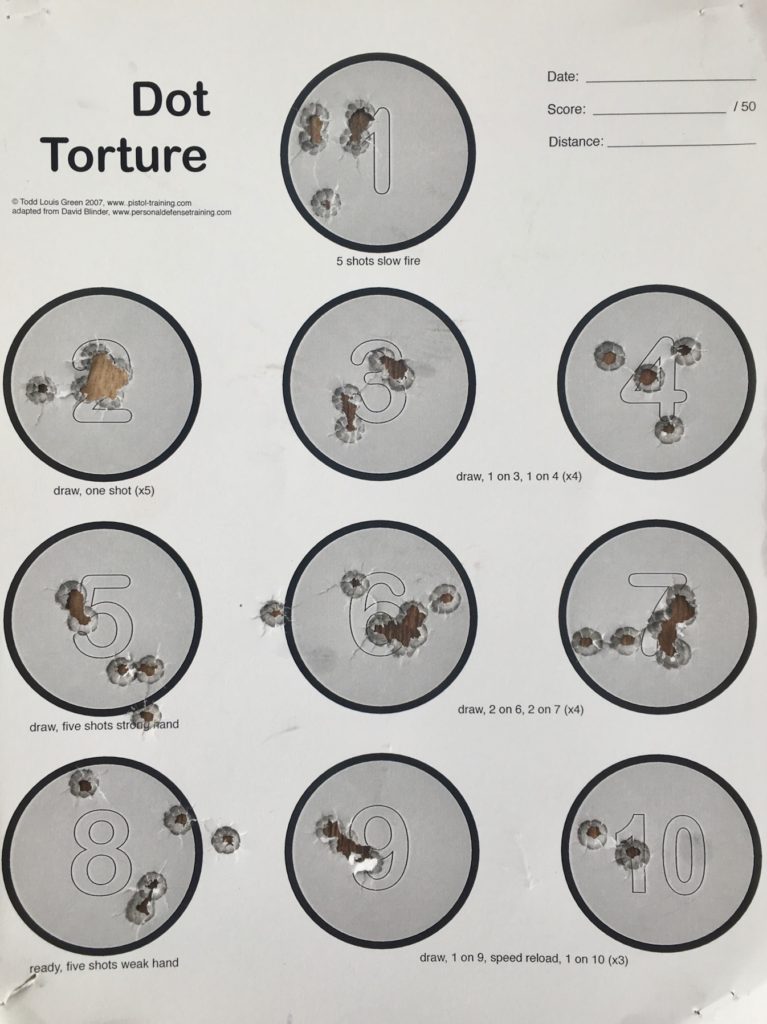
Carrying the Colt King Cobra
The sole RT-SOP criteria that I was unable to complete prior to publication was the concealed carry portion. This was due to unavailability of leather in time to get the requisite hours in. Not very many holsters are being manufactured for this revolver just yet, but Kramer Leather did step in and provide us a holster. Despite the shortcoming in our field report, Mike and I made an editorial decision to get this review out as quickly as possible.
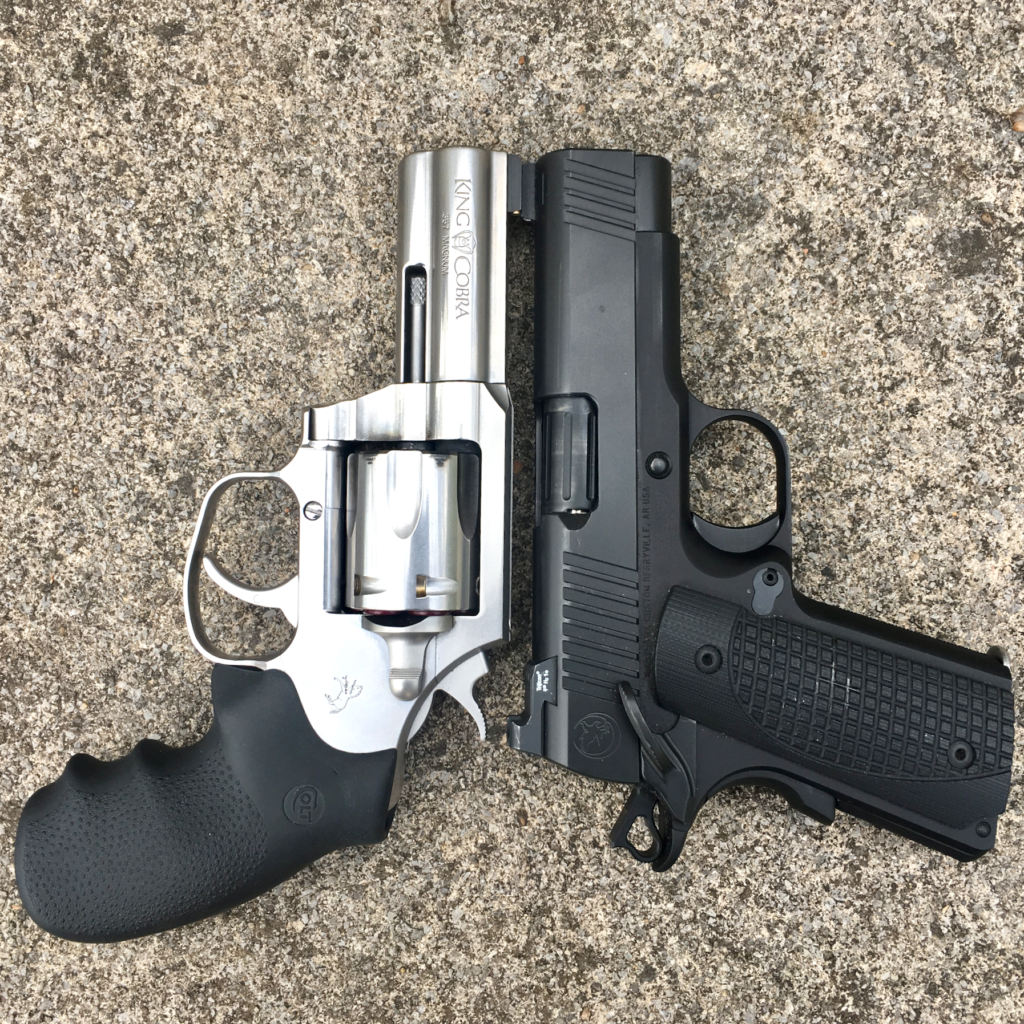
The Colt King Cobra is very similar in size to my daily carry pistol. I foresee few issues with carrying the King Cobra, but we’ll test it just the same. When we do we will post that as a separate, followup article that will be linked here. Speaking of follow-ons, stay tuned because I’ll be hanging on to this gun for a bit longer and I’ll make you guys aware of anything else I find out while using it.
The Bottom Line
This revolver fills an important role in the RevolverGuy’s battery, somewhere between his full-sized shooting iron and his snubby. My personal hope is that the Colt King Cobra (along with a couple others) are the vanguard of a trend toward revolvers in this class; small enough for daily concealed carry, but big enough to shoot comfortably and well.
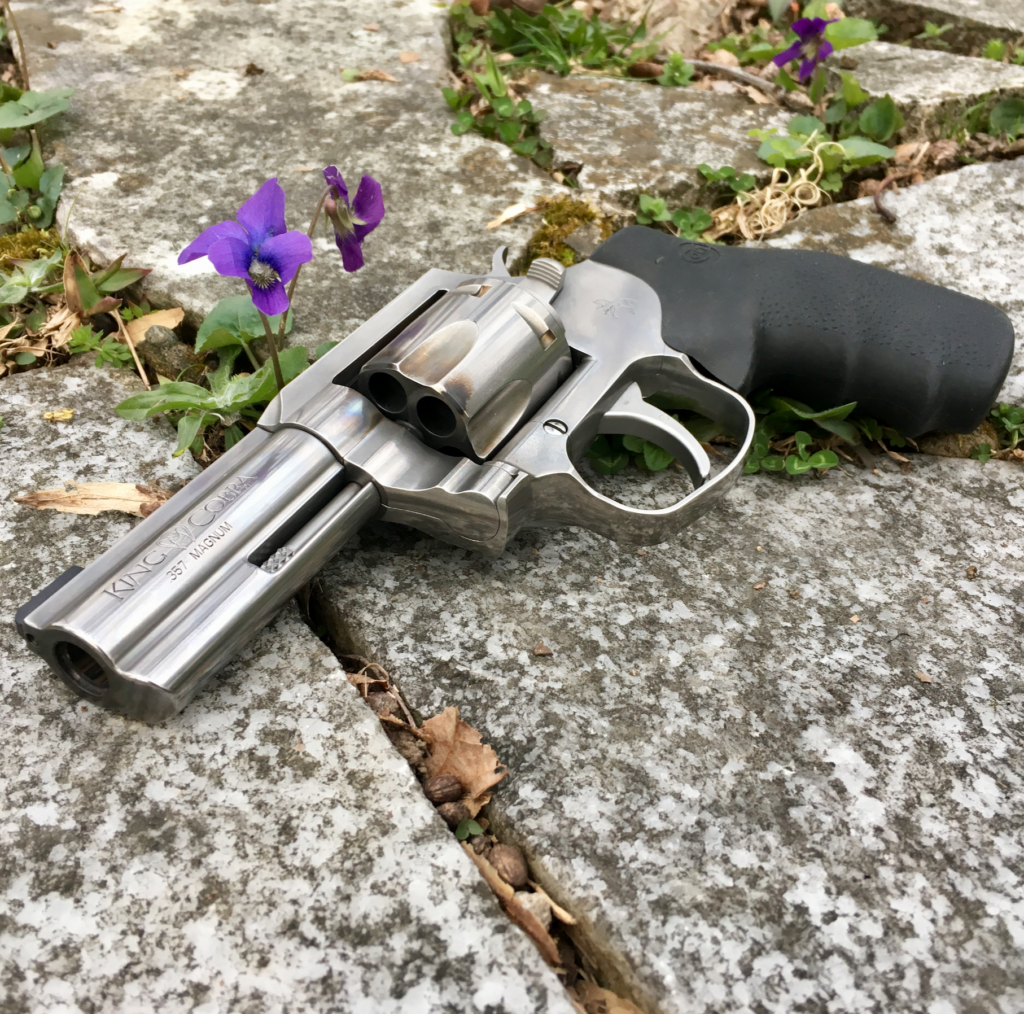
The Colt King Cobra isn’t perfect. If I had my ‘druthers I’d ask for a couple minor modifications: higher profile and/or adjustable sights, a wider trigger, and a friendlier ejector rod, in that order. Oh, and maybe a bobbed hammer. I’d also ask for the market to get on board with this excellent revolver and provide us with holsters and inline-operated speedloaders.
Despite these shortcomings, the Colt King Cobra is one of the best revolvers I’ve ever shot. My exemplar proved itself capable of extremely good accuracy within the confines of its sights, and it is pleasant with all but the heaviest Magnum ammo. The overall quality is one that is seldom seen these days. The trigger is outstanding, and the sixth shot is certainly a welcome addition. And of course, the three-inch, Goldilocks barrel and the beefy frame really make this revolver something special.
To paraphrase myself, revolvers will work if you’re willing to make them work. This one will probably work better than most, and it probably won’t take quite as much work as most. Though reports were mixed on the “new model” Cobras, the King Cobra is truly a phenomenal fighting revolver. The Colt King Cobra has an MSRP of $899, and I see them going for about that on Gunbroker. Honestly though, my exemplar seems to punch well above that weight class. If I didn’t know better you could tell me this gun cost a third more than that and I’d probably believe you.
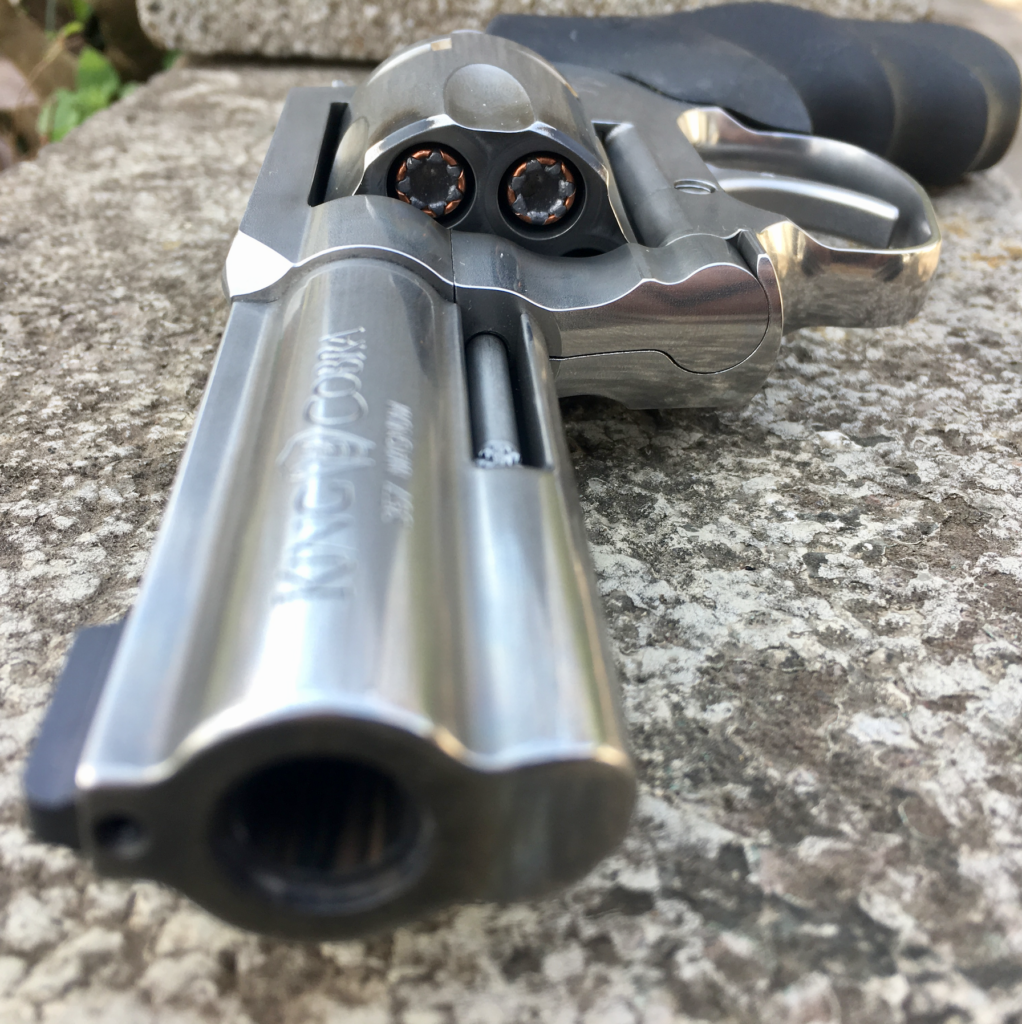
The bottom line is that this is a damn fine revolver. Had the King Cobra been an option when I initially entered the revolver market I daresay it would have been at the top of my list, provided aftermarket support made it a feasible carry option, and there’s a good chance I’d still be carrying it today.
†We have heard some anecdotal reports of poor accuracy with this load, and will be conducting some further testing of the .38 Special HST in the future.
††Because of this disparity, Mike and I have some additional testing planned to explore the accuracy differential between .38 Special and .357 Magnum loads from .357 Magnum revolvers. The questions raised in this footnote (and the footnote above it) probably merit benching the guns and doing some true inherent accuracy testing.

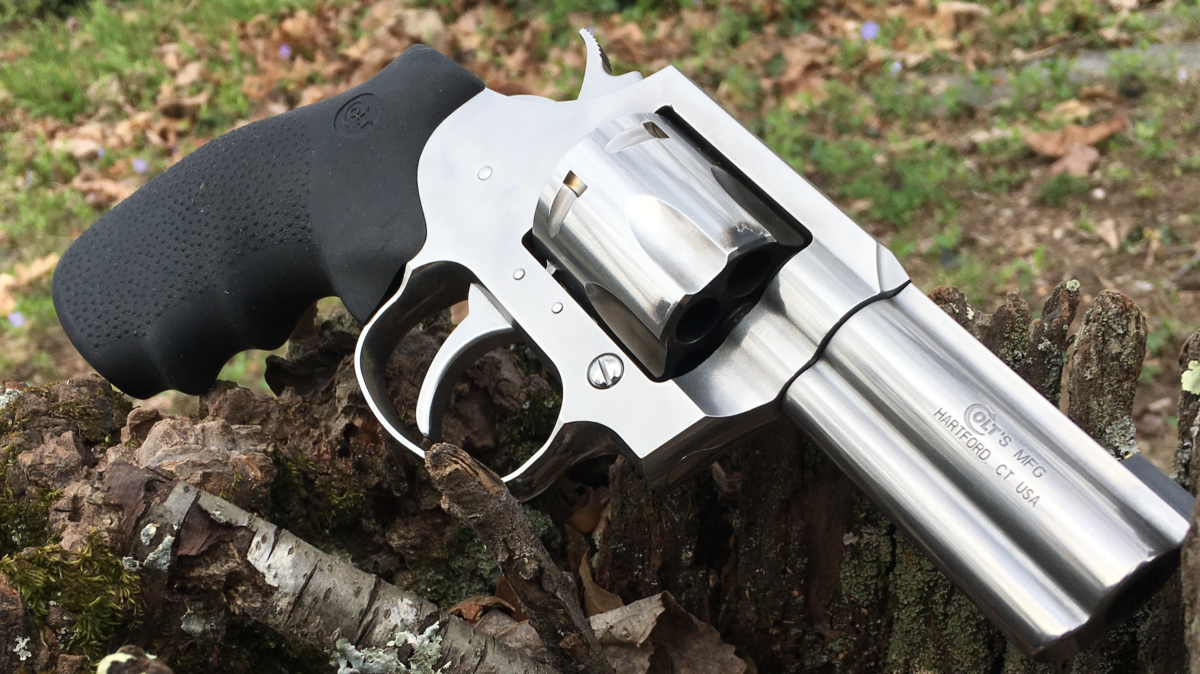
Look for this to return shortly with adjustable sights in that heavy top strap, a 4 inch barrel, with a rib on top and Python stamped on the barrel. Just Dreaming?????
We can certainly hope, Billy! Unfortunately I don’t have any inside info about Colt’s plans, but I’d love to have a chance to own a Python.
What speedloaders are available at this time? Also, is it similar in weight/bulk to the 3 inch Kimber? I know you mention it briefly, but…
The 3″ Kimber is advertised at 25.1 ounces; I weighed this gun at 28.2 ounces.
As far as I know, the only speedloaders available at this time are the 5 Star Firearms and HKS loaders.
You referenced my cigar punch comment from the first K6S post and tested the standard pressure Critical Defense .38. Do I detect some pandering?
Is there any chance you measured the cylinder width? I’m still curious if it is the same 1.40 inches as the Cobra; I haven’t been able to find that info anywhere yet.
While I’m asking, do you have the overall length and height, too? Those values are also conspicuously absent from the Colt sight and every other publication I can find.
Greyson,
I measure the overall length at 8 1/4″ and the height with factory grip at 4 7/8″.
Unfortunately I seem to have misplaced my calipers, but as soon as I find them I’ll get you a measurement on that cylinder.
About the Critical Defense – I’m going to say it pandered to me by being five dollars cheaper, and having five more rounds in the box than anything else on the shelf!
I’ve intentionally gone from Federal HST .38 130gr to the Critical Defense .38 +p 110gr, and not just because you get 5 more in the box (though that certainly sweetens the deal!) – the CD demonstrates some of the best performance for a .38 round in ballistics tests such as Lucky Gunner’s, in terms of a combination of penetration and expansion. The HSTs may expand more, but they tend to penetrate less. Plus, trying to load the HSTs quickly in my SP101 was next to impossible due to the nose profile, or lack thereof.
Hammer,
It might be worth double checking which Critical Defense load you have. The +P version of the Critical Defense really doesn’t do that great, especially if you have a slightly longer or faster barrel. The standard pressure load is quite good (and what I carry) especially when you take ease of reloading into account, but the +P version seems to expand too soon causing less penetration. I feel that the standard pressure Critical Defense beats out the HST without much issue for exactly the reasons you stated, but the averages the same or less penetrations and doesn’t expand as well.
That should say, “…but the +P averages the same or less…”
Thanks for your thoughts Greyson, and that mirrors my own observations as well. I only shoot the CD +P loads in my SP101 snubby, where they have performed well, but I agree that it’s interesting the standard pressure CD .38 loads do seem to perform slightly better on the whole.
In my longer barrel revolver, which is mostly for outdoors use, I generally use Fed 130gr .357 Hydra-Shok.
We keep Critical Defense in .38 +p in all the home-defense and carry revolvers save our Taurus, which makes do with Hornady’d standard pressure .38. I only pack .357 in the woods.
The CD really did perform well in Lucky Gunner’s testing.
Thank you very much.
I went out to my dad’s yesterday to shoot my new S&W 317. Afterwards, I enjoyed a cigar with he and a couple of his friends, but I didn’t think about using my revolver as a cigar punch until I had already bit the end off (yes; I am one of those heathens). I will try to remember next time so that I can give you an update on the suitability of revolver ejection rods as cigar punches in exchange for the measurements.
So I tried it last night. A S&W ejector rod will cut through about 2 tobacco leaves ok, but if the cap has a third layer or a vein, you probably won’t get all the way through. The LCR ejector rod worked slightly better and cuts a little bigger hole (and still about half the size of a real cigar punch). If you really want a punched cigar and you are stuck without any other tools, it would work, but neither of them is good enough for me to bother doing it that way on purpose again.
The cylinder is 1.40″ inches in diameter.
Awesome. So the frame has been beefed up, but the cylinder on this gun is the same as the new Cobra (and all D-Frames as far as I am aware). It also means the new King Cobra is only .01″ wider than the K6s.
Man I’ve been tempted to buy this revolver. I kinda wish it looked a little more classic, but it could still be a looker with the right set of grips. Colt triggers can be a little different if you’re used to S&W but you can get used to them easily enough. Do you know know if these are supposed to handle a steady diet of .357 like Rugers, or are they a little more delicate like the old K frame Smiths? Great write up by the way!
Ian, it’s my impression from shooting both guns that the frame on the new King Cobra isn’t as robust as the SP101. It’s not “delicate,” but it’s not a tank, either. Keep in mind that this frame isn’t as large as a medium (K) frame S&W. For comparison’s sake, it’s bigger than a small (J) frame, but not quite as big as a medium (K) frame. It can handle a reasonable amount of .357 just fine, but anytime you put a lot of them through a gun this size, you’re going to accelerate the wear and tear. A high-volume, “steady diet” of .357s is more appropriate for a service-size gun than a compact carry gun like this one. You can shoot a bucketful of Magnums through it if you want, and it will stay together, but it will go out of time or develop endshake much sooner than a gun with a heavier frame will. That’s the tradeoff when you go with a gun this size—they’re a joy to carry, but they’re also a little less tolerant of high-volume shooting with Magnums.
What’s “high volume?” Well, if you’re going to compete in one of the gun games, that probably qualifies. Weekly range trips that involve several hundred rounds fired in training and competition meets my definition of “high volume.” If you’re shooting like that, get a bigger, stronger gun, or plan to visit the gunsmith a little more frequently.
The two samples at SHOT Media Day probably digested something like 600 rounds a piece (just a wag, not an official number) in a single day, and they ran fine. Nothing broke. We were shooting 110 grain .357 Magnums that were loaded on the lighter end of the spectrum by DoubleTap. My guess is that most King Cobra owners will never push their guns that hard, and it would take them years to run that many Magnums through their gun. RevolverGuys are different, of course, but most gun owners don’t shoot as much as we do.
Hope that helps?
Thank you Mike, I really apreciate the comparisons and detailed response! I noticed the thick top strap (not sure about the forcing cone) and had been wondering about that for some time, but it would make sense that the recoil and small frame would wear it down earlier with magnums. I might have to buy it anyways, I could save most of the magnums for my Trooper mk 3 and just practice more with handloaded specials on a King Cobra. Thank you again.
No problem, Sir! If it were me, I’d buy the King Cobra without hesitation, but would also buy a GP100 to save my Trooper from the wear and tear! Hard to get Colt parts these days.
The forcing cone on the new King Cobra is actually improved over the K-Frames, because it doesn’t have the flat milled at 6 O’Clock. The frame is sturdy as well. What really takes a beating with lots of .357 fire are parts like the bolt and the crane. It’s easy to shoot a gun loose with a lot of .357, especially one with a trim, lightweight cylinder like the new King Cobra. Timing and endshake issues are your main concern, not frame cracking.
I wish they had either reintroduced the old King Cobra or a new version that was duty sized like the old one. I mainly fire 130 gr. fmj loads in my 1990 vintage 4″ King Cobra as well as my two SP101s, so I doubt they will be wearing out any time soon. But I like the idea of having a gun that is stronger than it has to be. If given the choice between the extra round of the new King Cobra or the strength of the SP101 for a carry gun I would go for the stronger more durable gun.
You might be interested in the newest Cobra variant—the 4”, adjustable-sighted, Target Model!
I, too, would like to see Colt’s build a Medium-Large frame again, but it appears they are currently committed to using the smaller, New Cobra frame as the basis for their line extensions. This makes a lot of sense, but I do hope that Colt’s will continue to grow the revolver catalog by adding some new frames down the road.
I agree I wish it had the adjustable rear sites at least a 4 or 5 inch barrel and I wish they’d make it in the blued steel
Check out the King Cobra Target. It checks two of your three boxes – everything except blued.
I guess I’m one of the fudds who wishes they hadn’t recycled the name, for tradition’s sake, but there’s a practical side to it as well. I’m hoping that we will eventually see a Colt-branded AA (Medium) Frame—like the “old” King Cobra—return to the lineup, and what would we call it then? This could start a cascade of recycled names that would cause guys like me fits. ; ^ )
It’s wonderful though, to see the rampant colt rearing on the side of such a nice revolver again. I was impressed with this gun when I got a brief opportunity to shoot it at SHOT, and think it’s the product that has allowed Colt’s to plant the flag, and firmly declare their intention to be a real player in the revolver business. The (new) Cobra turned heads because it was the first out the chute, but this (new) King Cobra turns heads on its merits.
I can’t wait to see what’s next. I expect that topstrap will wear some adjustable sights soon, and who knows what else will follow?
The industry needs to get in gear and get behind this gun, with holsters and loaders!
I can see why they went with King Cobra for this guy (given that it is a beefed-up version of the New Cobra), but, even as a youngster who isn’t attached to the old names, I have a hard time not thinking of this gun as exactly what it is: the New Magnum Carry. If I had been in charge of names, and had known that there would be what are currently called the Cobra and the King Cobra, I would have called them the Compact Carry and the Magnum Carry, respectively.
As far as I’m concerned you can call this thing a bicycle. The name on the side means nothing in comparison to the performance of the thing.
I think Justin did a very solid operational/observational review. As the King shares many similarities w/the Cobra, he hit the right up/down points. The Cobra & subsequent Night Cobra both have had ejection rod sticking issues. The Trigger is narrow and over long range sessions create a painful trigger finger. The trench sight picture was also a good point (tho for intended purposes do meet their aim). I’m glad he mentioned acclimation is needed for the trigger; as shortstroking happens easily after shooting Rugers/S&W’s. The Pro’s he mentioned are also on-point. Replaceable sight, excellent accuracy, perfect lock-up alignment, ‘buttery’ smooth trigger-pull, solid overall fitment and where the KC fits in relation to other revolvers in the market (to name a few). I also found Remington, in the Cobra line-up, to be to their liking. I’m not hung up on the new Colt comparison to yesteryear and glad Colt is making modern versions of the revered Snake Line. Look forward to follow-up reviews on these ‘Snakes’ by Revolverguy.
I haven’t experienced the ejection rod sticking issues you referenced in the shorter guns, in my limited experience with them. Can you explain?
It’s referenced in the article. Some have reported (including one first-hand report to me) that the ejector rod may stick when depressed too far or with too much force.
Yeah, just trying to get a sense of how widespread of an issue this really is. It never happened to me or the dozens of people I watched fire these guns, so I’m hesitant to label it a design issue (versus an individual gun issue) without more data. I’m hoping he can elaborate and fill in the blanks. On how many samples have you seen this occur? Different shooters or the same guy? Do you have to fully bottom out the ejector rod for it to stick? I don’t deny it happens, but I’m trying to learn more about it, because I haven’t seen it.
I had that problem (ejector rod sticking) with both my New Cobra and Night Cobra for about the first 200 rounds or so, but after that they both settled in and now eject perfectly fine. BTW, excellent article, thanks!!!
The weight of this gun is markedly less than my 3″ S&W M65, making it definitely a candidate for carry. The pull back cylinder release befuddled some in the old days, but I found that pulling back with my dominant thumb, rolling the gun to port, allowed the cylinder to drop out, where the ejector rod met my hand.
As for the Federal 130gr HST (flying solo cup), my J frame is so-so on it, and my M67 loves it. I think it was meant to be a ‘Minute Of Nostril’ type load to clean out a perp’s sinuses.
The internals are patterned after the Trooper Mark V and the original King Cobra of the 1990s except for the use of a highly modified ‘V’ mainspring. Colt changed the critical geometry of that leaf spring so it’s not in a “V” but more of a shallow “U”, giving it a different feel altogether. In my young cop days, our department armorer would modify the factory Colt springs on the 1954 model Trooper and Python (and Diamondback, and the other D frames) into this current configuration and it was nothing short of awesome (compared to the stack of the original).
Put a set of Colt adjustable sights on this, even introduce a 4″ with a half lug (like the original Trooper Mark III and Mark V) and it’ll definitely find its way into my inventory.
It is good to see Colt coming out of the dust, and out from under decades of mismanagement and ill thought out marketing.
l Like the way you think. 3″ half lug with adjustables is my idea of a GREAT carry revolver.
I’ve never liked the Colts affection for naming their fine revolvers after snakes. S&W got it write when the switched to the simple numbers. They had some good names for their revolvers back in the day mind you, but using a number sounds like your talking about a weapon not a match box car. I’ve never liked snakes. My Official Police, Commandos, Detective spl.,M&P, Victory, Combat Magnum are more like it I think.
I have a Ruger LCR and from what it can be prone to false trigger resets as well. Good review on the King Cobra BTW.
Thank you, Bob!
Excellent review. I handled a new Cobra the day I bought my K6S (800 rounds since August last year, no hiccups). I opted for the DAO Kimber to pocket carry. BTW, the Colt prices are coming down at the shows, as more come on the market, new and used.
The Cobra’s trigger impressed me as much as did the Kimber’s. I shoot a friend’s vintage 6” Python regularly and yes, the Colt trigger of old was really good. Never short-stroked it.
You nail the reason for a 3” gun like this. Today I am weeding on our farm and the Copperheads are emerging. It is a lot of work to hip carry my GP100, as I do back in the woods, and my K-frame has a 4” barrel too. So I tote a Taurus 85 all day, bending and squatting, never noticing it, but a 3” barrel would be just as good in the right leather.
Check with Rob at Simply Rugged. He will set you up with a great rig.
Hmmmm, as I’m rethinking my my mountain biking rig ( nw Montana) I’ve become aware of reliability issues w/ my glock 29 carry: mag release triggered, lack of a standoff device for close bear hugging sessions. As I’m trying to stay high speed, weight is a serious concideration as I roll with a prepared mind set. This looks pretty sweet to me. I’ve been doing some research on the LCRX 3” 357 as a possible fix. Any chance you might be reviewing that revolver in the future? Truly enjoy your blog, thanks.
For a few more ounces you might consider the King Cobra; they won’t make all the difference in carry, but they sure do make a difference when firing!
The LCRx isn’t ruled out, but it’s also definitely not a priority right now. We have several other T&Es to complete first. We will keep it in mind!
Thanks for writing in!
Justin, isn’t the LCRx the one with the steel (under polymer) frame? That gun seemed substantial to me in a way the LCR .38 did not, though both had fine triggers.
Justin I Do like the colt, however it’s almost a 1/2 lb more weight than the lcrx . Only a couple oz.s more than the glock 29 though.
@Montanalivin –
I’m in a neighboring state, where we contend with all the same big predators you do, and I mtn bike a lot. I’m curious – what’s your preferred way to carry when riding?
Hi hammer, hill people gear original kit bag. Of course I have a can of bear mace riding on it as well in a mystery ranch bear spray holster. Works well in conjunction with a camel back, with room to stuff various a sundries. Not as fast as a holster , but not bad. And it allows you to not freak out the local trail bunnies:)
Ha – that’s the exact same set up I use, right down to the Mystery Ranch bear spray holster. After getting used to a Kit Bag, I rarely go in the woods without it anymore.
Yeah, it’s a sweet bag. I utilize the little trigger kidex holster thingy for the glock 29. However my chest on multiple occasions has dumped my mag in the bag. No good
I’m a kit bag fan too. I carry a S&W 610 in mine along with all the usual things I used to stuff in pockets. It’s a great piece of gear.
Not sure if you’ve seen, but S&W recently re-released the 610. I just ordered ammo today – we should have one on the way shortly!
Thanks for the thorough review. Your positive experience with the new King Cobra is made all the more valid by your clear experience foundation with S&Ws, but you didn’t let it bias your review of a Colt.
I go back and forth between S&W and Colts without trouble. Shooters my age were probably hoping for clones of the original V-frame King Cobra, but truthfully I think Colt is making the right move by challenging their design engineers to re-imagine their revolvers for current economic realities and current manufacturing technology. I hope the new KC sells like crazy and they continue to expand their DA revolver line.
Many thanks for the comments, Brent!
I selfishly hope the KC sells like crazy so the aftermarket will get on board with holsters and (we can keep hoping!) a good, inline speedloader!
Thanks again,
Justin
Justin, no problem and thanks again for the great review. As for the 610 finally coming back after an eleven year absence, I almost fell off my couch when I read it was back. I am eager to see your review. The 610 is my all time favorite handgun.
It was one of my favorites for a long time, too. The GP100 is definitely going to give it a run for it’s money as the 610 is an N-Frame and probably a tad oversized for the task. Also, there’s that lock hole in the side…
I’m reserving judgement until I have a chance to review it, though!
WOW! Well-done review. Good looking Revolver, in my NHO. I’d say that heavy topstrap is just waiting for adjustable sights! 28 ozs? Seeing as how my 586 was 42ish ozs, and I could carry it all day, this looks like a good understudy. The trigger reset is troubling, although no problem was found during the many-round firing. But…a Sergeant said to me…”That piece of equipment has been in use for 40+ years and I NEVER have heard of Anyone cutting themselves on it!” Murphy was an optimist! But…I haven’t shot myself in the foot..yet!
Is the trigger something that may need an engineering tweak, do you think, or maybe it would “wear in” with use? Definitely will add it to my “Would Like” list.
I can induce the reset lockup issue on all of my Ruger’s, my Charter Arms, my Armscor, and my dad’s Taurus. I don’t have any experience with the Kimber K6s, but I found a Kimber forum post that says it can be induced on that gun, too (https://www.kimbertalk.com/forums/kimber-revolver-forum/29954-k6s-trigger.html).
The only thing all of those really have in common is that they use a transfer bar. Smith & Wesson’s use a hammer block that basically works the opposite way (the transfer bar fills the gap between the hammer face and the firing pin during firing; the hammer block stays out of the way during firing so the hammer face strikes the firing pin directly, then, when the trigger is released, the hammer block moves up to hold the hammer away from the firing pin). I don’t know that the reset lockup issue is directly related to the design using a transfer bar, but it seems likely given my experience.
I know Grant Cunningham, back when he was still doing gun smithing, listed reducing the prominence of that false reset point on Rugers as part of his action work. I’ve never handled a gun he worked on, so I don’t know how much difference it makes, but it does sound like you can reduce the likelihood of it mechanically. That said, I would guess this is more a scenario where you just have to teach yourself to allow the full reset.
Thanx for the explantation!
Now I think I know why I never have had a trigger problem with any of my revolvers. Being totally self-taught from gunzine articles from my favorites…Skeeter, Bob Milek, Jeff Cooper and Mas Ayoob and others in the ’70s and ’80s , I just naturally figured that you should let the trigger fully do its thing. It seemed to work for me, even with my few semi autos, and during IPSC competition. (Always finished somewhere near the middle of the pack, even against with the other guys with their autopistols!)
Good information, here! Keep it up!
Carl, the trigger reset is just a fact of life with the Colts (and some other guns, as Greyson noted). It’s not really a gun problem, but more of a shooter problem. Allow me to explain . . .
As I remember it, the notion of “riding the sear” came into vogue in the mid-80s. This was a byproduct of the wholesale transition to DA/SA pistols by the military and law enforcement, because the troops were struggling with that DA-to-SA transition. Oftentimes, they’d crank through the generally-miserable (compared to a revolver) DA trigger and then apply the same kind of uncontrolled, brute force to the SA trigger, with predictably poor results (both in terms of accuracy and NDs). Some frustrated trainers hit on the notion of riding the sear as a way to get students to stop mashing the daylights out of the SA trigger. Feeling for the reset made them slow things down enough to exert some finesse and control, and the method became a popular tool to “fix” the problem.
Enter the Glock a few years later, with its very definite reset, and the die was cast. As that gun became more and more popular, it encouraged the mainstreaming of the trigger-reset philosophy. Before long, riding the sear was being universally taught in LE/MIL circles, and it carried over into the private sector as well. I first encountered it in the military when we transitioned to the M9 pistol, but later saw it in private schools and LE training.
Before the 1980s, revolver shooters knew to let the trigger travel fully forward, and didn’t spend any time feeling for a reset point short of the trigger’s resting position. Shooters were taught to maintain contact with the trigger face, but not to restrict its forward travel with added tension—let the trigger move fully forward to rest, then stroke it again.
That bit of corporate knowledge faded after the 80s, and even shooters like me—who grew up on DA revolvers—began to develop bad trigger habits as they spent more time with the new autos and practiced feeling for the reset.
In my own case, I short-stroked the new Colt King Cobra at SHOT, and attribute it to bad habits from several decades of autopistol training with a sear-reset philosophy (which I’ve been desperately trying to correct, but it’s easier to learn bad habits than to unlearn them). Had I properly managed the DA revolver trigger by letting it go forward to reset, instead of feeling for a click, I wouldn’t have had the problem.
RevolverGuys are less susceptible to short-stroking S&Ws, because that action doesn’t have a dramatic “false reset” like the Colts do, and the rebound slide springs are pretty authoritative and tend to push the trigger finger forward with more gusto. Simply put, even if a shooter has bad habits of feeling for the reset, the S&W doesn’t offer them as much of an opportunity to fall for the bait.
But the Colts do. Not just the new ones, but the old ones too. I dug an old Police Positive and Python out, and guess what I found? False resets. As Greyson noted, they’re not alone. In fact the worst I’ve uncovered so far is the Ruger LCR that I’m currently working with—that gun has a noticeably sluggish and weak trigger return (probably a byproduct of making the pull so light and easy to manage), and several hitches that could encourage a “sear-finding” trigger finger to stop prematurely. Great gun, but definitely a minefield for a sear-resetter who tries to manage the trigger’s return, instead of just letting it happen.
So, it’s really up to the shooter to know his gear and work it properly. If you buy the new Colt (or Ruger, or . . .), you have to build the proper habits to use it efficiently, which includes letting the trigger run to full reset. That’s the way it has always been, but we just lost the path a few years back and are only now regaining it.
I agree and disagree. I agree on the point that it is a fact of life with Colts, and that training is the answer. If you have designs on carrying/using this gun, don’t let this stand in your way. Train to it and you’ll be fine.
I disagree pretty strenuously with the idea that this is the result of training around “riding the reset” and/or lots of work with semi-autos. I’ve put this revolver in the hands of a shooter who has never heard the term “ride the reset” but who on her very first trigger cycle experienced this issue. Additionally, I’ve yet to have this issue with a Ruger; if this were a simple issue of a training groove it would manifest on similar revolvers, which is pointed out to point out the distinction with the King Cobra. That’s not to say it can’t be induced in a Ruger, but it is to say it doesn’t happen on its own.
I think there are two factors at play with the King Cobra. The first is that the “false reset” is quite pronounced. I’ve been in classes where instructors have taught the reset with 1911s and Glocks and the whole class has to stop, the instructor has to pause and say, “now listen” and slowly release his finger, then ask, “didja hear that click?” That’s not the case with the King Cobra – the reset is loud and proud. The second factor is that it the trigger reset tension drops to almost nil at this point. It might be helpful to think of this as “reverse stacking”. As the trigger moves forward it gets lighter and lighter, and after the audible/tactile click it is very, very close to nonexistent, so if you’re feeling for a lack of resistance rather than a click, you’ve found it…but you still have to let off the trigger just a bit more.
All of which is to say, there is a difference with the King Cobra. It certainly isn’t insurmountable for a dedicated shooter, but it also isn’t isolated to a sear resetter’s problem.
Actually, I think we’re mostly on the same wavelength. My comments were aimed at why a seasoned shooter might struggle with it, particularly one without much time on Colt revolvers—which is most of the shooting population these days, including me. I’ve got some Colts, but they don’t get much use because they would be difficult to replace if they broke. I just don’t know the Colts as well as the S&Ws, because they don’t get much exercise.
A new/inexperienced shooter is a different case. They haven’t been taught sear riding, but they may not allow the trigger to fully reset as result of general inexperience, or a lack of experience with the Colt system in particular. Once again, they’re not as likely to do this on S&Ws because the S&W system more forcefully resets the trigger, and it lacks the distinct, false reset of the Colt. A newbie might have no problems with a S&W, but experience the reset problem on the Colt immediately, because the Colt system behaves differently.
There’s no doubt the Colts have a false reset that’s missing in some other systems, but it’s not a roadblock to adopting these fine guns. It’s just a training thing, and if you work with the system a bit, you’ll get into the groove quickly enough. I certainly wouldn’t pass up the new King Cobra because of it. You’d be missing out on a great gun with a great—although different—trigger.
Just learn your equipment and you’ll be GTG. I think we’re in lockstep on that.
One of the attractions for me to 3″ revolvers is that they normally have full-length ejector rods. The King Cobra does lot; it looks like a snub-nosed ejector rod.
Do you know why Colt didn’t fit the King Cobra with a full-length ejector rod.
It’s not a snub-nosed length ejector rod. It’s quite longer than a snubby, but not quite as long as a full-sized 686/GP100.
“Full length” is something of a subjective term. I think it would be quite fair to call this full length.
Thanks for the great review.
I think it may be time for “my wife” to get a new gun.
Just a thought for all those wanting to put adjustable sights on this:
I carried concealed revolvers for a living for about 20 years, both fixed sight (Model 65, Model 10, Speed-Six, various D-frames and J-frames) and adjustable sight (Model 66, Python, Security-Six), and the adjustable sights always tore up my cover garments. The sharp corners on the Python’s rear sight were the worst, the rounded corners on the Model 66 were the best (or the least-worst).
I decided that the the ne plus ultra in concealed revolvers was a fixed-sight, round-butt, 3-inch, stainless revolver in .357 Magnum. And the big agencies who carried all concealed all the time (FBI, DEA, ATF, INS, and U.S. Marshals) all issued or authorized fixed-sight, round-butt, etc., .357 revolvers.
Adjustable sights may be the bee’s knees on the range, but when you carry a concealed revolver day in and day out, they can get knocked out of alignment or broken more easily than you might think. I’d stick with fixed sights on a carry gun. Of course, it’s America, and you can go to your church and I’ll go to mine.
Completely agree! Fixed sights rule for carry guns. However, I’d like to see the adjustables for field and range use, or as a home defense gun.
Hi Justin,
I thoroughly enjoy your site and have been waiting patiently for you guys to review one or more variants of the Ruger SP101, or at least mention it more often for comparison. I realize it is 30 year old technology but I think it is still an excellent weapons system albiet with some limitations. Still would appreciate your and Mike’s opinions on it. Any chance we might see that in the future? Thanks and keep up the exceptional work!
Andrew, I’m currently finishing some work with an LCR, and Justin has a few other guns in inventory that he’s exercising, but I wouldn’t be surprised to see an SP101 get added to the rotation sometime. I shot a .327 Federal version last year that I was pretty impressed with. The SP is a great gun, and definitely worth the look.
Andrew,
To echo Mike the SP101 is a fantastic gun and we will certainly review it eventually. The reason for its absence is simply that neither of us own one and we’ve had too much stuff in the queue ahead of it, but we’ll get there!
Justin
Ok thanks guys!
Justin, exceptional review, thank you.
After only 50 rounds of American Eagle 38SPL and 12 rounds of Hornady Critical Defense .357 Magnum, there is significant, mutiple lines of deep flame cutting on the top strap of my new King Cobra. Have you experienced the same?
JWT
JWT,
Thank you!
I do see those lines, though I believe they are remnants of cutting the threads for the barrel.
There are a couple things to contraindicate flame cutting. First, there are several of them; flame cutting tends to be concentrated across a single line. Secondly, they’ve occurred so quickly and in your case with only a few rounds of .357. It would probably take at least a couple (several?) hundred .357 rounds before the line would become significant enough to notice, let alone that deep. Thirdly, mine are visible above the forcing cone, as well as just behind it, which also isn’t typical of flame cutting.
I’m working on getting a pic up to see if we’re seeing the same thing.
Those are most definitely tooling marks, not flame cutting.
I have no doubt of that, but not sure that’s what the original poster is seeing or not.
Justin, thanks for the reply and I apologize for checking back so late. Once the revolver was cleaned I see that it is exactly as you have described, tool marks, not excessive flame cutting.
Since that time, I have looked at quite a few new production Colt double action guns, and they all have those tool marks, to some extent.
Thanks again for a great review and replies.
Jon, without seeing your gun, it’s hard to comment, but I have seen guns where a buildup of leading looked an awful lot like flame cutting. See if you can scrape it off with the sharp edge of a brass case.
Will any of the parts in the the New King Cobra fit in an older King Cobra. Like the transfer bar with
it’s attached hand spring?
I don’t know for sure, but it’s doubtful, Mark. The New King Cobra frame is a different size than the old, so most of the internals would probably not match. Plus, the new gun incorporates some MIM, and those parts are usually not the same dimension as forged/milled steel parts.
It would be nice to know for sure. I see the hand spring as the weak link in the older King Cobras. They often fail to keep their tension and it is getting harder to find replacements.
Mark,
I would suggest reaching out to Colt, or a qualified Colt gunsmith. Without a specimens of each, side-by-side, and someone more knowledgeable in the inner workings of Colt’s revolvers than Mike or me, anything we could tell you would just be a wild guess.
Thanks,
Justin
I’d suggest calling Colt’s Customer Service. Hopefully they can tell you.
I went to the gun show today looking for a King Cobra to check out in person but didn’t have any luck finding one. Maybe I’ll try one of the bigger gun shops in Dallas. Does anyone know if they are making different grips for these yet? The gun seems to be about the perfect size for carrying everyday but those grips are kind of a turn off, for myself anyways.
They are available on Gunbroker, though that would incur shipping and transfer costs.
As I mentioned in the article, VZ is making aftermarket grips for the new Colt’s revolvers.
Thank you Justin. I read this article a while ago, must have forgotten about the vz grips.
Ian, the Altamont Co. has a nice selection of grips for what they’re calling the “2017 Cobra.” Lots of handsome materials/colors to choose from there.
https://www.altamontco.com/pistol-grips/colt/cobra/
Thank you Mike, that’s exactly what I was looking for! I really apreciate it.
Groo here
The universial revolver reload is fine for matches but not so good for serious.
I also trained with Cuningham [ revolver class — LOVED IT] but we used the police
reload..
This does many things, as the barrel is up ant dirt falls down in the cases not under the star.
The cylinder release can be hit regardless of the type .[using the right hand]
The off hand thumb is used to push the ejector. [the pad of the thumb is tuffer than the palm
of the shooting hand and if cases stick damage to the left thumb is of less import
than a hole in the shooting hand ,,, seen it and dune it several times]
Lastly the fingers can be used to add in rotating the cylinder for loading.
Carried a gold star for 30+ and revolvers for the first 12.
The false reset is a bad habbit.
Mitchalack never lightens his return spring for this reason.
Those who shot revolvers alot learned to relax the finger to allow the trigger to reset
without loosing contact with the trigger.
It can happen with a new shooter as well as an auto shooter.
But glock type shooters have the most problem…
Have the lady let the trigger push her finger forward, forget what you hear or feel.
She will soon get the feel of it…
I’d really love to buy one of these new Colts, but until they make an aluminum frame version I just can’t. Steel is way too heavy for my method of carry.
This is very encouraging.
Question: as the new King Cobra–or at least the 3″ fixed-sight version–appears to be intended to be a carry gun, has anyone done any chronograph testing with it using defensive ammo or equivalent handloads?
Just wondering.
There’s an article here with some “tested” velocities. Careful what you read…his published numbers have the 3″ KC pushing the Federal 158-grain load at carbine velocities.
Personally, as the new King Cobra appears to be intended to be a carry gun, I don’t feel that chronograph results are all that important.